Post Production
Guidelines
These guidelines have been earmarked as being specific to the above-named department, however, we know that the work carried out during any production area can vary.
Please be aware that many other safety guidelines may also apply to you depending on the type of work you are currently undertaking.
Please also familiarise yourself with all guideline sections to ensure you are fully informed.
Who needs to read this?
The Health and Safety at Work Act 2015 requires all PCBUs to identify drug and alcohol use as a hazard, and therefore eliminate or minimise the risk.
All workers on a production (pre, during and post) should read and understand the section below on ‘Minimum Responsibilities’.
Roles that have specific responsibilities, or influence, over workers should read the section below on ‘Planning and Guidance Considerations and Responsibilities’ – this includes Producers, Directors, Production Managers, Line Producers, Heads of Department, Assistant Directors and Health and Safety Officer.
What we need to know about Alcohol and Drugs
The use of drugs and alcohol, even if consumed outside work hours, can lead to poor concentration, carelessness, fatigue, risk-taking behaviour, and errors in judgement. Misuse of drugs and alcohol not only affects work performance, but also results in higher rates of injuries, fatalities, and absenteeism.
- Alcohol includes any substance or beverage that contains ethyl alcohol including, but not limited to, beer, winepress-mix drinks and other spirits.
- Drug – a medicine or other substance which has a physiological effect when ingested or otherwise introduced into the body.
Safety sensitive tasks
Safety-sensitive tasks are ones where impaired performance, for whatever reason, could affect the safety worker or others around. While misuse of drugs or alcohol is a risk in any situation, the risk is heightened during safety-sensitive tasks.
For example, working on a film set is safety-sensitive because of the inherent risk. Other safety-sensitive roles include, but are not limited to:
- driving – at all times – not only when shuttling participants;
- construction;
- electrical work;
- rigging;
- tasks working at height;
- operating machinery and tools
- emergency response roles, which may include all staff in an operation.
-
* see - Guidance for Managing Drug and Alcohol-related Activities
Minimum Responsibilities – for Everyone!
All workers should:
- report any personal medical situations that the producer should be aware of;
- advise the Producer, their Supervisor or the Health and Safety Officer if other workers appear to be intoxicated or under the influence of drugs or alcohol which may impede their own or the safety of others;
- advise the Producer, their Supervisor or the Health and Safety Officer if other workers speak about taking drugs or alcohol in a situation that may put other sat risk;
- understand the risks associated with taking drugs(prescribed or otherwise) and alcohol;
- understand that some prescription and over-the-counter medication can lead to drowsiness;
- follow all procedures and controls put in place to keep themselves and others safe when working in noisy environments;
- understand the taking recreational drugs and alcohol outside of work can affect their ability to function safely and put others at risk, and be aware that drugs and alcohol can stay in their system for some time; and
- not turn up to work still under the influence of drugs or alcohol.

Planning and Guidance Considerations and Responsibilities
Anyone who is responsible for, or has influence over, workers should read and understand this section, as well as the minimum responsibilities for everyone.
This includes the Production Company, Producers, Directors, Line Producers, Heads of Department, Assistant Directors and Health and Safety Officers.
Drug and Alcohol Policy
The policy should:
- ensure workers understand your expectations – for example drug and alcohol-free work environment;
- be developed with good faith in mind;
- outline any proposed monitoring;
- outline how you will respond to misuse of drugs or alcohol, in the short-term (immediate safety risk) and longer-term (future expectations) – this may vary depending on whether the worker:
- shows signs of misuse of drugs or alcohol;
- has been involved in a workplace safety incident;
- is convicted of a drugs or alcohol offence – for example what is the policy if someone is convicted of drink driving.
- Drug and alcohol testing
* view Worksafe's information on Alcohol and Other Drugs in the Workplace & How to Develop Alcohol and other Drug (AOD) Policy.
Contracts / work agreements
If the production company decide that drug and/or alcohol testing is appropriate forth production, it is advised that a clause on testing is included in work agreements / contracts; this clarifies that workers consent to drug and alcohol testing.
If the production company chooses to include a clause on drug testing in its work agreements or contracts, if so this should be outlined in the policy.
Drug testing could occur:
- pre-contract;
- if there is a reasonable cause to believe someone may be under the influence; or
- post-safety incident.
Reasonable Cause
The production company or person in charge may require a worker to be tested if there is reasonable cause or reasonable grounds for suspecting they're impaired while at work. This includes factors such as the worker being:
- involved in a workplace accident or near miss – for example a lapse of concentration when driving;
- unreliable – for example being absent or late regularly, or an inability to remember instructions;
- performing poorly – for example poor judgement and decision making, reduced reaction times and efficiency, or increased error rates.
Before deciding to test, you should allow the worker to comment on the concerns. It may reduce any question of bias if more than one person makes a decision to require a post-incident test. Your safety management plan should state who will make the decision.
* Download: Hazards - Reasonable Cause Indicators Process Form
Fatigue
Sometimes, signs of drugs and alcohol misuse are signs of general fatigue. Even if you accept that in a particular case fatigue is the cause of poor performance and testing isn’t appropriate, it’s still important to stand down the worker from safety-sensitive tasks.
Post-Incident Testing
Post-incident testing is a standard procedure is becoming more common. However, it is important to remember that following an incident there may be higher priorities than testing for example first aid, trauma management, and evacuation.
If the police are involved, they may test at the scene. In other situations, the production company or person in charge must decide what is an appropriate time after the incident to test. In making this decision you should consider the length of time alcohol and drugs are present in a person’s system. See the “what to test for” table for more information.
Random Testing
Random testing should only be conducted when staff are working in safety- sensitive roles. The privacy rights of staff will outweigh an employer’s wish to be consistent across all staff and random test any staff member irrespective of staff members’ work roles.
* View information on Worksafe's view of Impairment and Testing for Drugs at Work
WHAT TO TEST FOR:

Production Company
The production company (likely to have primary responsibility over health and safety on the production) should develop a drug and alcohol policy.
The production company should:
- ensure workers affected by drug or alcohol use are managed according to the drug and alcohol policy;
- ensure workers presumed, or known, to be impaired by drug or alcohol use are treated fairly; and
- respect a worker’s right to privacy when/ if they inform the production company of use of prescribed or over-the-counter medication.
Person in charge
Anyone who is responsible for, or has influence over, workers is a person in charge and should read this entire chapter. This includes the Production Company, Producers, Directors, Line Producers, Heads of Department, Assistant Directors and Health and Safety Officers.
If it is suspected that a worker is misusing drugs or alcohol, it is recommended, as a first step, that the appropriate person in charge (this may be the Head of Department, Producer or Health and Safety Officer)and the worker talk about the problem to try to resolve the issue.
If a worker is caught misusing drugs or alcohol, the production’s response should be clearly outlined in their Drug and Alcohol Policy, and followed by the person in charge – this may include testing.


Alcohol and Drugs
Electrical
This chapter provides guidance in relation to electrical safety on a production, and is primarily based on New Zealand legislation and guidance issued by WorkSafe NZ, the BBC and IEE Wiring Matters.
Who needs to read this?
All workers who undertake electrical work should read and understand the section on ‘minimum responsibilities’.
Any person who is responsible for supplying electrical equipment to a production, both from the supply company and the production company; as well as any person who plugs anything into the electrical supply.
Roles that have specific responsibilities, or influence, over electrical work should read the section on ‘planning and guidance considerations’ – this includes producers, directors, production managers, line producers, heads of departments, assistant directors and health and safety officers.
Definitions
Competent means a person who has through a combination of training, education and experience, acquired knowledge and skills enabling that person to correctly perform a specified task.
Qualified electrician is a person who has both a current electrical registration and practicing licence.
RCD is a Residual Current Device.
What specific electrical risks are there on production sets?
- Arcing.
- Electric faults can result in a fire.
- Contact with electricity causing electrical shock and/or burns.
- Exploding bulbs/lamps.
- Generators incorrectly specified/setup for use.
- Power overload.
- Equipment falling over and causing injury.
- Electric cables and wires may create a trip hazard.
- Using electrical equipment in higher risk environments: wet, damp, humid, dusty conditions, increases the hazards significantly.
- Overhead obstructions.
- Radiation burns.
- Batteries can cause fire if the terminals come into contact with conductive materials.
-
Minimum Responsibilities for Electrical Work
Everyone on a screen production should read and understand this section.
If you have planning responsibilities for, or planning influence over, electrical work you also should read and understand the following section on planning and guidance considerations and responsibilities below.
If you undertake or are responsible for, or have influence over, electrical work you should also read and understand the section on responsibilities specific to electrical work below.
Only those persons accredited under relevant legislation shall be engaged to undertake electrical maintenance and or installation.
If electrical equipment starts to burn or smoke:
- isolate the electrical supply if possible;
- use carbon dioxide or dry powder extinguisher, if competent to do so, but do not put yourself in danger;
- avoid inhaling fumes from burning plastics; and
- call emergency services – dial 111.
All workers should:
- have a basic knowledge of electrical safety, if they are expected to handle electrical equipment;
- understand the risks associated with electrical work;
- ask the gaffer/electrician before plugging any cable into a distribution board/socket;
- immediately advise the producer, or person with delegated responsibility, and electrics crew of all potential electrical hazards;
- use personal protective equipment when required; and
- advise their supervisor or the health and safety advisor when they observe unsafe electrical work.
Workers should NEVER:
- place liquid (drinks) on any electrical appliance or fitting;
- walk on, drive over, or stand on cables – sudden or continuous weight can create a weak point in the cable and cause an electrical fault; and
- attempt to investigate or repair faulty equipment unless they are qualified.
Planning and Guidance Considerations and Responsibilities
Everyone has planning responsibilities for, or planning influence, over electrical work should read and understand this section, as well as the minimum responsibilities for everybody.
This includes funders, the production company, producers, heads of departments, and health and safety advisors.
Anyone who is responsible for or undertakes electrical work should also read and understand the next section – responsibilities specific to electrical work.
Funders
Funders should:
• be assured, through the provision of the production’s health and safety plan, that the funding provided is adequate to provide for competent people to undertake and supervise all electrical work and appropriate electrical equipment.
Production Company
In pre-production, production companies (likely to have primary responsibility over health and safety on the production) should:
- ensure that at least one member of the crew dealing with electrical matters is suitably qualified;
- consider the potential risks associated with electrical work when planning and allocating tasks;
- ensure the potential risks associated are appropriately managed, either eliminating or minimising them; and
- engage competent persons to oversee and undertake all electrical work associated with the production.
Producer / Production Manager
As Producers and Production Managers have oversight across the production, they should:
- engage competent people to undertake and / or supervise electrical work;
- consider the potential risks associated with electrical work when planning and allocating tasks;
- manage the potential risks associated with electrical work, either eliminating or minimising them;
- engage competent persons to oversee and undertake all electrical work associated with the production;
- ensure all crew are advised of any electrical hazards as necessary and immediate steps must be taken to eliminate or minimise the risk; and
- consider whether a specialist company may be required to produce a suitable electrical design
Heads of Department
Heads of department’s whose department undertakes any type of electrical work should ensure a competent person undertakes that work and read the section on responsibilities specific to electrical work.
Health and Safety Officer
The Health and Safety Officer should ensure potential risks associated with electrical work are discussed with all cast and crew during health and safety inductions and / or as required if circumstances on the set change.
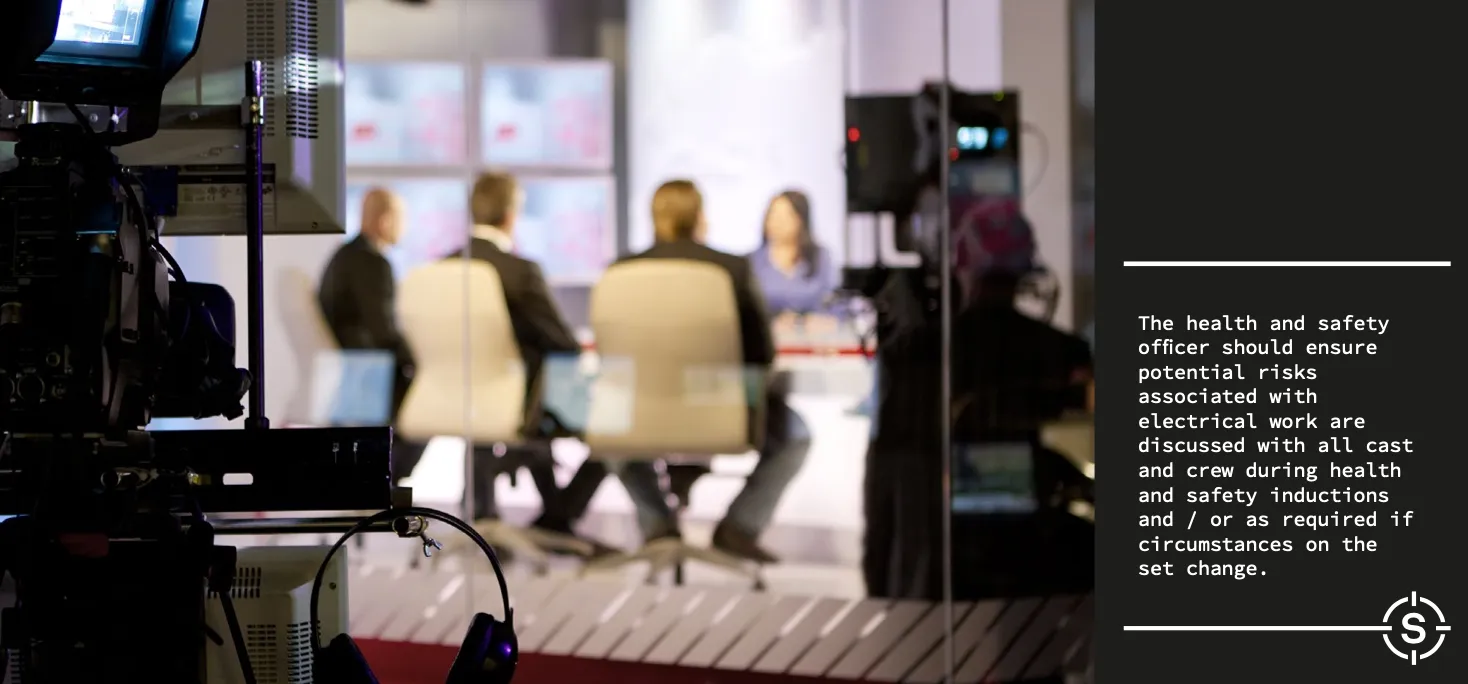
Responsibilities Specific to Electrical Work
Everyone who undertakes or is responsible for, or has influence over, electrical work should read and understand this section, as well as the previous sections.
This includes electricians, Gaffers and anyone undertaking or with responsibilities or influence over electrical work on a production.
Anyone bringing electrical items to a production should also be aware of and comply with:
- AS/NZS 3760:2010 – specifies the requirements for safe inspection and testing of electrical equipment in the workplace.
Anyone undertaking electrical work must comply with the following standards:
- AS/NZS 3010 – all electrical work must be carried out in accordance with the Electricity Act 1922 and Electrical (Safety) Regulations 2010.
- AS/NZS 4249:1994 – specifies the requirements for safe working practices in the use of electrical equipment on film, video and television sites and the in-service testing of the equipment, and must be followed,
- AS/NZS 3760:2010 – specifies the requirements for safe inspection and testing of electrical equipment in the workplace.
Any person responsible for, or with influence over, electrical work, likely to be the gaffer or head registered electrician, must ensure:
- all crew are advised of any electrical hazards as necessary and immediate steps must be taken to eliminate or minimise the risk;
- where practicable, all final circuits must be protected by a 30mA Residual Current Device (RCD);
- electrical work is carried out by a competent person, this is either a:
- ~ - registered electrician with current practising licence; or
- ~ - electrical service technician with current practising licence; or
- ~ - electrical appliance service person with current practising licence; or
- ~ - person working under supervision of the above;
- the installation of fixing wiring and electrical equipment to production sets is carried out by a competent person, as define above;
- electrical equipment is well maintained;
- electrical equipment / devices are tested for function by a competent person – testing requirements must follow those outlined in legislation and NZ standards AS/NZS 3760:2010;
- electrical equipment whether onset, in offices or workshops display a current test tag to AS/NZS3760:2010
- leads are off the ground or protected where practicable;
- electrical equipment/devices are protected from the weather, or constructed to a suitable IP rating;
- cables and distribution are of sufficient size and capacity to do the required job;
- cables are not twisted, crushed or kinked;
- cables are secured and clearly identified;
- cable routing is carefully considered and does not create a tripping hazard;
- power is turned off when installing power distribution equipment.
Minimum clearance between equipment and overhead electric power lines
Anyone supervising or operating equipment near or under power lines is responsible for ensuring the following is adhered to:
- Overhead power lines (conductors) are an often overlooked danger. Be alert for the presence of overhead conductors when operating cranes, boom swinging, carrying tall objects, being in a boat with a mast up on the water or on a trailer on land.
- When operating mechanical equipment near overhead electric power conductors the requirements of the Electricity Regulations 1993, clause 82 (3) and (5), and NZECP 34,1993 apply. There is a minimum clearance of four metres. Consult your local power supplier who may permit closer operation for lower voltages. Written permission is required to operate closer than four metres.
- When travelling on the road, the requirements of the Transport Act 1976 apply.

Managing the Risk
How do I control risks associated with Electrical Work?
First, you must consider whether you can eliminate the risk, if this is not reasonably practicable then you must minimise that risk – this is called the hierarchy of controls.
Appendix 2: health and safety risk assessments process will further help you understand how to use the hierarchy of controls.
The Risk of Electrical Shock and Fire
Risks associated with temporary installations are those of electric shock and fire.
These arise from:
• the temporary nature of the installation;
• lack of permanent structures;
• severe mechanical stresses; and
• access to the public.
Attention should be paid to:
• suitability of the equipment for the environment;
• earthing and bonding requirements;
• connection to the supply; and
• use of accessories of the appropriate Degree of Protection (IP code) to suit the external influences.
* see TEMPORARY POWER DISTRIBUTION SYSTEMS AND ELECTRICAL SUPPLIES FOR ENTERTAINMENT RELATED PURPOSES

Gaffer and/or Head Electrician
By law, electricians have greater authority and responsibility than non-electricians in matters around electricity. If the head gaffer is not an electrician, the head electrician within the department, where the work is occurring, is responsible for all electrical items on the job.
Gaffers and/or the head electrician should:
- manage and represent the electrical crew under their supervision;
- ensure the electrical competency of all electrical crew under their supervision;
- undertake a risk assessment for all electrical work undertaken by you and your team;
- check all electrical equipment is sound before use and, where applicable, testing certificates are current.

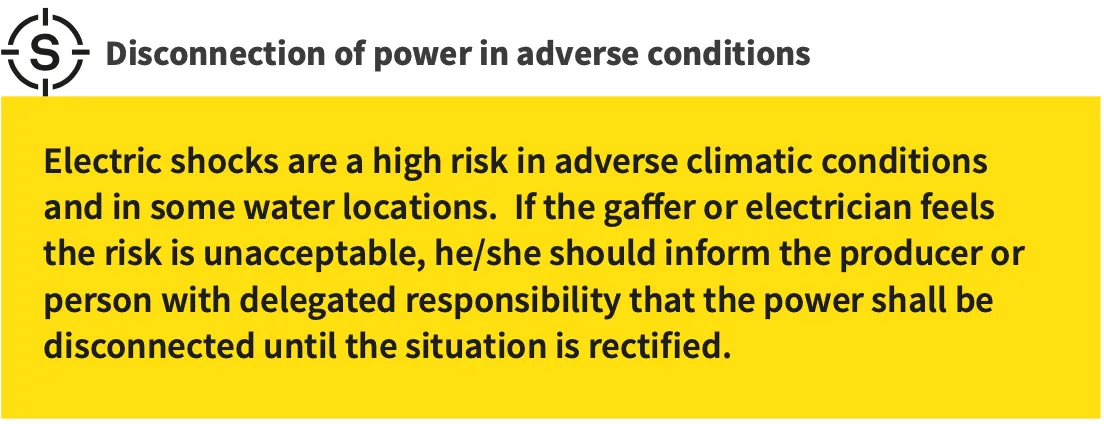
Training
As part of all PCBU's primary duty of care to provide and maintain a safe and healthy work environment, they must ensure workers have had the necessary training to allow them to undertake their work safely.
Anyone who has direct oversight of electrical work should ensure the crew undertaking the task/s are adequately trained and competent in their work.
Things to think about include, does the worker require:
- a qualification to undertake the task;
- supervision by a competent person, if they are new or don’t have the required level of training?
- basic training teaching them how to undertake the task safely; or
- basic training teaching them how to ensure the risk control is effective, including use of personal protective equipment?


Electrical
Fatigue
Productions can be a demanding undertaking, not only in the duration of the production but also in the hours expected of cast and crew on a daily basis. We need to look after our people and consider the potential for fatigue throughout a production and how we can manage it.
While how to manage fatigue is not specifically legislated, under the Health and Safety at Work Act 2015 we are all responsible for workplace health and safety, and that includes fatigue.
This chapter is primarily based on guidance issued by:
- WorkSafe NZ;
- the Canadian Centre of Occupational Health and Safety;
- the New Zealand Film & Video Technicians Guild and The Screen Production & Development Associations; and
- WorkSmart, United Kingdom.
The chapter also draws from The Blue Book: The Code of Practice for the Engagement of Crew in the New Zealand Screen Production Industry.
Who needs to read this?
All workers involved in a production have health and safety duties regarding fatigue and should read and understand the section on ‘minimum responsibilities for everybody’. Roles that have direct influence over other workers should also read the ‘planning and guidance considerations’ section; this includes production company representatives, producers, directors, production managers, heads of departments, assistant directors, health and safety officers and location managers.
Definitions
Definitions specifically related to fatigue.
Day off is an unpaid scheduled period, usually at the end of the working week intended for rest. Specified timings for short and long term engagements are outlined in the Blue Book.
Fatigue is the state of feeling very tired, weary or sleepy resulting from insufficient sleep, prolonged mental or physical work, or extended periods of stress or anxiety.
Jet lag is the rapid movement (faster than one time zone per day) across more than three time zones.
Rest an uninterrupted period during which work should not be undertaken – in a production it is ideally a 10-hour stand-down.
Scheduled day means the set period of time in which a worker is scheduled to carry out their duties.
What we need to know about Fatigue
What is Fatigue?
Fatigue is a state of physical and/or mental exhaustion that may impair an individual’s strength, speed, reaction time, coordination, decision making capability or balance, diminishing their ability to perform work safely and effectively. Fatigue reduces alertness, which can lead to errors and an increase in workplace incidents and injuries.4
Research has shown that people who have gone without sleep for an extended period of time are just as impaired as people who are over the legal alcohol limit.
Fatigue can be described as either:
- acute – resulting from short-term sleep loss or short periods of heavy physical or mental work, and usually can be reversed by sleep and/or relaxation; or
- chronic – the constant, severe state of tiredness that is not relived by rest, with symptoms similar to the flu and can last longer than six months.
Types of Fatigue
Circadian rhythm disruption occurs when a worker’s normal, 24-hour, rhythmic biological cycle is disrupted from its current setting due to either:
- shift lag – one or more nights of work; and
- jet lag – rapid movement (faster than one time zone per day) across more than three time zones.
Cumulative fatigue or sleep deprivation is when a worker’s mental capability is weakened due to disturbed or shortened major sleep periods. Several major uninterrupted sleep periods will be needed to reduce or eliminate the sleep debt.
Emotional fatigue can result from excessive job and/or personal demands and stress.
Mental fatigue can be caused by continual mental effort and attention on a particular task, as well as high levels of stress or emotion. Mental fatigue can be related to cumulative fatigue or sleep deprivation.
Physical fatigue is when an individual’s physical capability is weakened due to over-exertion – both prolonged physical activity and brief but relatively extreme physical activity can tax a worker’s physical endurance or strength beyond their normal limits. Physical fatigue can either be due to dynamic work, where muscles are continually moving, or static work, where muscles are held tense.
Find out more about common types of fatigue in Appendix 1 below.
What causes Fatigue?
Just as there are different types of fatigue, there are many different reasons why fatigue may occur; it is important we are all aware of what can cause fatigue so we can help prevent it from occurring.
While the most common cause of fatigue is disturbance to sleep, with fatigue being higher among shift-workers, there any many reasons why fatigue may occur and we should consider all possible factors.
The below tables outline some factors that can contribute to fatigue within the screen sector.

How do we identify Fatigue?
Some symptoms of fatigue can only be identified by the individual:

Other signs can also be identified by others:

These lists of symptoms are not exhaustive, and you should consult a professional if you have concerns about fatigue on the production set.
A checklist for identifying fatigue, and causes, can be found in Appendix 2 below.
Minimum Responsibilities for Everybody
Everyone involved in a screen production should read and understand this section.
Everyone involved in a production should:
- understand what causes fatigue;
- understand the signs and symptoms of fatigue, for both themselves and others; and
- ensure they advise the Health and Safety Officer, their direct supervisor, the Assistant Directors, and/or the Production Manager/office if they become aware of fatigue or the potential for fatigue.
Everyone is responsible for ensuring their exposure to fatigue is minimised to prevent risks to health and safety, and should:
- have a nutritious diet;
- get adequate sleep, this could include, but is not limited to:
- knowing about sleep, sleep disorders and sleep hygiene
- exercising regularly, but not just before going to bed
- using bed primarily for sleeping
- avoiding caffeine, tobacco and alcohol, especially close to when you plan on sleeping
- making the bedroom as quiet and dark as possible
- negotiating with others if sleep must occur during the day
- understand what tasks to do and what not to do if sleep is compromised
- get adequate meal and rest breaks during work shifts;
- have adequate rest between shifts; and
- use recovery time wisely.
Stimulants
The use of stimulants, such as nicotine, caffeine, and some other drugs, can help maintain alertness in the short-term; however, they can cause individuals to “crash” as the effects wear off, and lead to poor quality sleep.
If cast and crew are constantly relying on stimulants to keep them alert, we need to consider what is causing the fatigue and what can be done to prevent, or reduce, it.
* Coffee is not a solution to fatigue, it merely masks it.
Sleeping tablets can reduce fatigue, if used appropriately and for limited periods of time. However, each different type has advantages and disadvantages and generally they just mask the problem if the causes of sleep problems remain unchanged.
Planning and Guidance Considerations and Responsibilities
Everyone who is responsible for, or has influence over, an activity or task in relation to a production should read and understand this section, as well as the minimum responsibilities for everybody.
This includes funders, production company representatives, directors, producers, production managers, line producers, heads of department, assistant director/s and health and safety officers. All of whom should follow the guidance provided in the below sections on ‘identifying the risk of fatigue’ and ‘managing the risk of fatigue’, as well as the section for their specific role.
Assessing the Risk of Fatigue
Everyone who is responsible for an activity or task in relation to a production should understand what causes fatigue and know how to identify fatigue. We are all responsible for taking reasonable care of our own health and safety and ensuring that our actions, or inactions, do not harm others – including understanding fatigue.
It’s important that we don’t solely rely on someone already showing signs of fatigue to identify the risk of fatigue occurring.
We should all consider fatigue when:
- a new job is started;
- there is a change or increase in work demand;
- designing work schedules and allocating tasks;
- assigning physically or mentally demanding tasks; or
- moving across time zones.
The risk of fatigue can also be assessed by:
- consulting with cast and crew;
- looking at work practices and schedules;
- reviewing previous safety event information; and
- using specific assessment tools, if required – see Appendix 3 below for an example.
The risk of fatigue should always be considered across all roles on a production. In particular, fatigue needs to be constantly monitored in higher-risk areas of work, such as driving, operating heavy machinery or equipment, working at heights, working in extreme environments, working with hazardous substances or electrical work, or stunt work.
Fatigue on the Production Set
There are specific circumstances on a production that can contribute to fatigue. We should all know and understand what these are:
- repeated, long and extended hours;
- difficult technical setups;
- poor production planning; and
- bad weather delaying productions.
While we cannot predict the future, some of these causes of fatigue can either be avoided or managed through proactive and smart planning.
A key component of risk management is about identifying the potential for fatigue. If we are aware of a risk that could cause fatigue, and we do nothing to try to manage that risk then something goes wrong – we haven’t done our job to ensure the health and safety of all workers and others affected by our work.
* If something goes wrong because someone was fatigued, and you could have managed the circumstance that led to that fatigue, how would you feel?
Managing the Risk of Fatigue
While it is understood that production sets are not your typical 9-to-5 workplace, fatigue must still be managed. Everyone responsible for setting or organising an activity or task in relation to the production should always consider how they could prevent fatigue from occurring.
* Remember, as PCBU’s and individual workers we are all responsible for making every effort, so far as is reasonably practicable, to ensure the safety of ourselves and others.
Below are some key factors that should be considered to help prevent fatigue from occurring.
Work Schedules
* The search for the perfect work schedule is a wild goose chase; but by acknowledging the need for balance and flexibility we can help prevent fatigue.
- The Blue Book: The Code of Practice for the Engagement of Crew in the New Zealand Screen Production Industry should always be consulted when setting work schedules.
- Schedule tasks suitably throughout a work period.
- ~ It is important to understand that for most people their ability to be alert or to focus is at its lowest between 3am and 5am, and 3pm and 5pm. During these natural low-function times, adopt a conservative approach to safety and avoid critical jobs, where practicable.
- If night work is deemed essential to the production, fatigue must then be considered as an increased potential risk.
- Consider how people will get to and from work
- .~ Workers who don’t work traditional 9am-5pm days, such as screen industry crew, have more accidents commuting to and from work than those who do work 9am to 5pm, which are likely to be caused by fatigue.
- Try to schedule work so workers can get at least two consecutive nights’ sleep (with a normal day in between) each week, as this will help reduce the risk of fatigue.
- Ensure, so far as is reasonably practicable, that working hours are not too long. If longer working days are required, consider staggered start and finish times, and/or longer rest breaks and periods off work.
- Ensure the schedules allow enough recovery time for a good nights’ sleep.
- Monitor and place limits around overtime worked. Avoid incentives to work excessive hours – remember, every extra hour worked is an hour’s less recovery time.
Sleep
- Design schedules to allow for good sleep opportunity and recovery time between work days.
- Design schedules that minimise disruptions to natural sleeping rhythms.
- If night work is required, try to limit a workers’ number of scheduled nights in a row.
* Remember people are ‘programmed’ to be awake during the day and asleep at night
Environmental Conditions
- Avoid working during periods of extreme temperature, or minimise exposure through job rotation.
- Outdoor work, rough surfaces, sloping surfaces, wind and sunlight / heat can all cause fatigue.
- Provide adequate facilities for rest breaks, such as shade and access to potable water.
Physical and Mental Work Demands
- Limit periods of excessive mental or physical demands (ie through job rotation where practicable).
- Ensure fit for purpose plant, machinery and equipment is used at the workplace.
- Make sure workloads are manageable. Take into account work flow changes due to factors such as production delay, machinery breakdowns, unplanned absences or resignations. Avoid impractical deadlines.
Emotional Well-being
- Where possible, be aware of personal circumstances that affect your workers and provide support. Allow time off where circumstances require. As appropriate, ensure co-workers are aware of any important issues affecting their colleagues.
- Create a positive work environment where good relationships exist and workers are encouraged and supported. Provide good supervision.
Facilities
- Ensure there is good lighting and ventilation.
- Provide rest facilities where possible.
- Provide healthy meals – nutritional requirements vary from daytime to night-time and should be considered.
Workplace Fatigue Policy
Consider developing a fatigue policy to sit alongside your health and safety policy. The policy should include information about:
- maximum workday length and average weekly hours;
- work-related travel;
- procedures for reporting fatigue risks; and
- procedures for managing fatigued workers.
Make sure anyone can report fatigue-related issues, and ensure you investigate incidents where fatigue may be involved.
Responsibilities
Funders
Funders should:
- be assured, through the provision of the production’s health and safety plan, that the funding provided is adequate for the proposed length of the production process, so as not to lead to fatigue; and
- incorporate health and safety clause/s in the funding agreement, which might include expected standard hours of engagement.
Production Company
In pre-production, production companies (likely to have primary responsibility over health and safety on the production) should:
- consider whether the proposed length of the production shoot, the locations or other factors, and daily hours could lead to fatigue; and
- clearly articulate the requirement for fatigue to be managed through the production life-cycle.
The production company should consider developing a fatigue policy to demonstrate commitment to fatigued management.
If it is not reasonably practicable to manage the risk of fatigue and reduce hours of work during the production, the production company should consider providing:
- nearby accommodation; and/or
- transport.
Producer / Production Manager
As Producers and Production Managers have oversight across the production, they should:
- consider the potential for fatigue when planning and allocating tasks;
- ensure the potential for fatigue is either eliminated or minimised;
- provide adequate rest between or during shifts; and
- ensure the potential for fatigue and any controls in place are included on daily call sheets.
If it's not reasonably practicable to manage the risk of fatigue and reduce hours of work, the Producer should consider providing:
- nearby accommodation; and / or
- transport.
Line Producer
Line Producers also have oversight of the production process and should create a production schedule that provides adequate time for the work to be undertaken.
Director / Heads of Department
Directors and Heads of Department should:
- consider the potential for fatigue when planning and allocating tasks; and
- ensure the potential for fatigue is either eliminated or minimised.
Assistant Director/s
The Assistant Director/s should:
- ensure the potential for fatigue is discussed with all cast and crew during health and safety inductions and / or as required if circumstances on the set change;
- create a production schedule that provides adequate time for the work to be undertaken;
- understand how to identify and control fatigue;
- ensure appropriate people are informed if crew members are fatigued, for example heads of department; and
- report incidents of fatigue where necessary, for example if fatigue leads to a notifiable event.
Health and Safety Officer
The Health and Safety Officer should:
- work with the Producer, Production Manager and Heads of Department to help them identify the potential for fatigue;
- ensure the potential for fatigue is discussed with all cast and crew during health and safety inductions and/or as required if circumstances on the set change; and
- understand how to identify and control fatigue; and
- report incidents of fatigue where necessary, for example if fatigue leads to a notifiable event.
Appendix 1
Comparison of types of fatigue common to the screen industry
The two tables below describe several characteristics of types of fatigue common to the screen industry.


Appendix 2
Identifying Fatigue and Causes Checklist
This checklist provides guidance to assist in identifying fatigue but is not an exhaustive list of risk factors. If the answer is yes to any of the questions, fatigue risks should be further assessed and control measures implemented, as required.
Click HERE to view and download the Fatigue Checklist.
Appendix 3
Tools to determine Levels of Fatigue
Prior Sleep and Wake Rules (PSWR) are based on the sleep requirements of the average adult, and can be used to calculate the likelihood of fatigue.
The PSWR are likely to underestimate the fatigue likelihood score (FLS) in older adults, teenagers and those workers who suffer from disrupted sleep. Therefore, it should be used with caution.
The following table uses PSWR to help determine a fatigue likelihood score.

Based on the FLS, a worker or supervisor can then refer to a fatigue likelihood profile. This is not prescriptive but can be used to determine what an acceptable FLS is based on operational tempo or tasks being planned.
The following table is an example of fatigue likelihood profile:

Other Tools and References:
Fatigue Prevention in the NZ Workplace - Guidebook
The Fatigue Scoreboard - (xlsx worksheet to help determine risk)
Canadian Centre of Occupational Health and Safety. 2016. Fatigue.

Fatigue
Guidelines for Covid-19 - May 2024
Removal of COVID-19 public health requirements:
The New Zealand Government removed the remaining COVID-19 public health requirements. This approach reflects the downward trend in case numbers, hospitalisations, and the populations high level of immunity.
Removal of the Public Health requirements means that mandatory isolation for positive cases and mask wearing is no longer required.
Recommendations:
The recommendation from the Te Whatu Ora, Health NZ is to isolate for 5 days from the day you tested positive or symptoms first started, whichever is first.
The HSWA still requires a PCBU and workers to provide a healthy & safe workplace where we look out for each other and not put others at risk, including exposure to illness.
ScreenSafe NZ encourages crew to stay home if they are unwell and test if you have COVID-19 related symptoms.
Testing
You should undertake a COVID-19 test if you have cold, flu or COVID-19 symptoms as soon as you start feeling unwell.
There are two main types of testing for COVID-19 in Aotearoa New Zealand: Rapid Antigen Tests (RATs) and PCR (nasopharyngeal, nasal & throat and saliva) tests.
RATs are available free for personal use and whanau from various public site like pharmacies, healthcare providers, libraries and community hubs. A detailed list for free RATs is located here.
Whether positive or negative, RAT results should be reported through this site.
Even though the COVID-19 public health requirements have been removed, a PCBU/business may choose to undertake surveillance testing using PCR or RATs to enhance production continuity. This will enable early detection and prevent further spread throughout a production. The costs associated with surveillance testing is the responsibility of the PCBU/business.
More information on testing can be found here
PCR Testing Providers
Central Safety Ltd – salivatesting@centralsafety.co.nz
APHG - https://covid19salivatesting.co.nz/

Guidelines for Covid-19 - May 2024
Hazardous Substances
Anyone using a hazardous substance should have a thorough understanding of the Health and Safety at Work (HazardousSubstances) Regulations 2017, which set out the rules for work-related activities involving hazardous substances.
The Hazardous Substances Toolbox website also provides comprehensive information on how you can work safely with hazardous substance.
This chapter provides basic guidance and key things for you to consider in relation to working with hazardous substances on a production.
Who needs to read this?
All workers who undertake work with, or work that interacts with, hazardous substances should read and understand the section on ‘minimum responsibilities’ and ‘managing hazardous substances’.
Roles that have specific responsibilities, or influence, over work with hazardous substances should read the section on ‘planning and guidance considerations’ – this includes producers, directors, production managers, line producers, heads of departments, assistant directors and health and safety officers.
Definitions
Hazardous substance means, unless expressly provided otherwise by regulations, any substance —
- with one or more of the following intrinsic properties – explosiveness, flammability, a capacity to oxidise, corrosiveness, toxicity (including chronic toxicity), ecotoxicity, with or without bioaccumulation; or
- which on contact with air or water (other than air or water where the temperature or pressure has been artificially increased or decreased) generates a substance with any one or more of the properties specified above.
MSDS means Material Safety Data Sheets; these provide concise safety and health information about the hazards and safety precautions of the substance and should be available for all products.
Specific Risks
- Explosiveness
- Flammability
- Health effects
- Infection
- Toxicity - both short and long-term effects
*NOTE: Substances may be inhaled, ingested or absorbed into the body. The effect is dependent upon the substance involved and the degree of exposure.
What we need to know about Hazardous Substances
Many hazardous substances are in daily use on a production set. While all hazardous substances can be safely used if proper work methods are adopted, safer, alternative substances and/or work methods should be used instead of using highly hazardous substances where practicable.
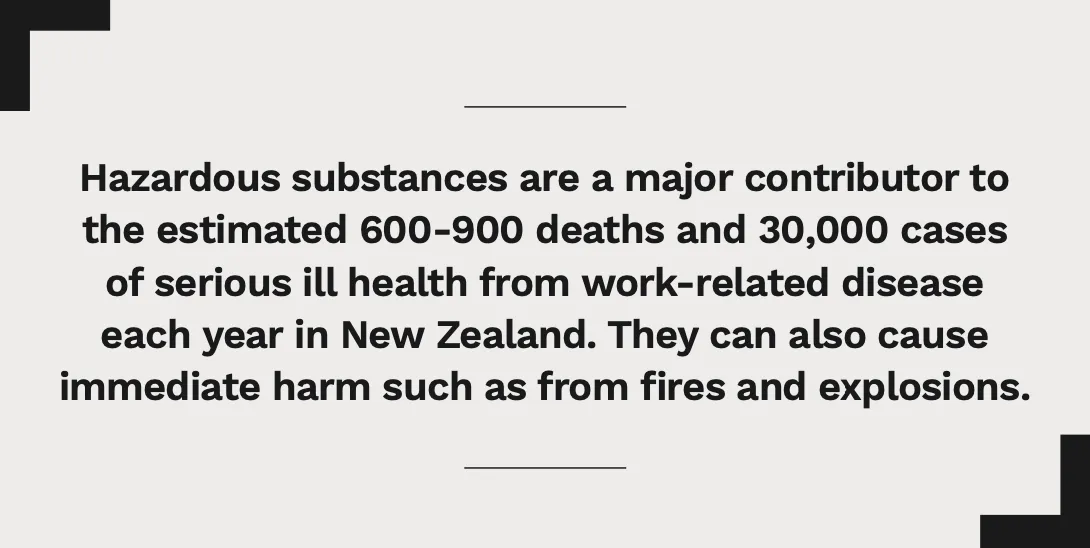
What is a Hazardous Substance?
A hazardous substance is any product or chemical that has explosive, flammable, oxidising, toxic, corrosive or ecotoxic properties.
Explosive: explodes or causes explosion.
Flammable: ignites easily and burns rapidly.
Oxidising: could be gaseous, solid or liquid and can cause or intensify fire and explosion.
Toxic: can harm people if it enters the body through contact, being inhaled or ingested. The effects can range from mild to life-threatening, and can be immediate or long-term.
Corrosive: can cause severe skin burns and eye damage. Ecotoxic: is toxic to the environment.
All hazardous substances should have an MSDS, provided by the supplier of the substance – these provide concise safety and health information about the hazards and safety precautions of the substance.
*See: WorkSafe / What the Hazardous Substances Regulations mean for you
What could go wrong?
Emergencies you need to consider and plan for include:
- a worker being poisoned by ingesting or inhaling a toxic substance;
- a worker being burnt by a corrosive substance;
- a fire caused by flammable or oxidising substances; or
- hazardous substances leaking or spilling from their containers, injuring people and contaminating land and waterways.
*See: WorkSafe / Emergency plans
Certified Handler requirements
Some work with highly hazardous substances must be carried out by a certified handler.
Certified Handlers need to:
- meet certain competency requirements, and
- receive workplace-specific information, training and instruction by or on behalf of the business, and
- obtain a certified handler compliance certificate from a compliance certifier.
You need a certified handler for:
• substances that require a controlled substance licence (CSL), such as most explosives, fumigants and vertebrate toxic agents (VTAs); and
• acutely toxic (6.1A and 6.1B) substances.
*See: WorkSafe / Certified handler requirements
Minimum Responsibilities
Everyone on a screen production who does, or could, work with hazardous substances, should read and understand this section.
All workers must:
- follow all health and safety information, training and instruction they have received;
- must be aware of what personal protective equipment they are expected to provide themselves and what will be provided by the production;
- follow instructions provided by the person in charge of any activity that involves the use of, or is conducted near, hazardous substances; and
- know escape routes when working around or near hazardous substances; if they are unsure of the escape route check with the 1st assistant director to learn the escape route before entering the work area.
Managing Hazardous Substances
Anyone who operates or is responsible for, or has influence over, hazardous substances must read and understand this section, as well as the sections on minimum responsibilities and planning and guidance considerations and responsibilities.
Create an Inventory
First and foremost, it’s important to know what hazardous substances are being stored or used on a production.
- Make an inventory of all the hazardous substances manufactured, used, handled or stored at your workplace including hazardous waste.
- Keep your inventory up-to-date and accurate.
- Make sure your inventory is readily accessible to emergency services workers.
The Hazardous Substances Calculator will help you create an inventory and work out what key requirements you need to meet, based on the hazardous substances you use, handle, manufacture and store at your workplace.
*See: WorkSafe / Inventory
Assess and Manage the Risk
All hazardous substances have a level of risk.
If there is no alternative and it is necessary to use hazardous materials on the production, those responsible for the use of the hazardous substance need to identify all risks associated with the hazard and decide on how to manage the risk by minimising it.
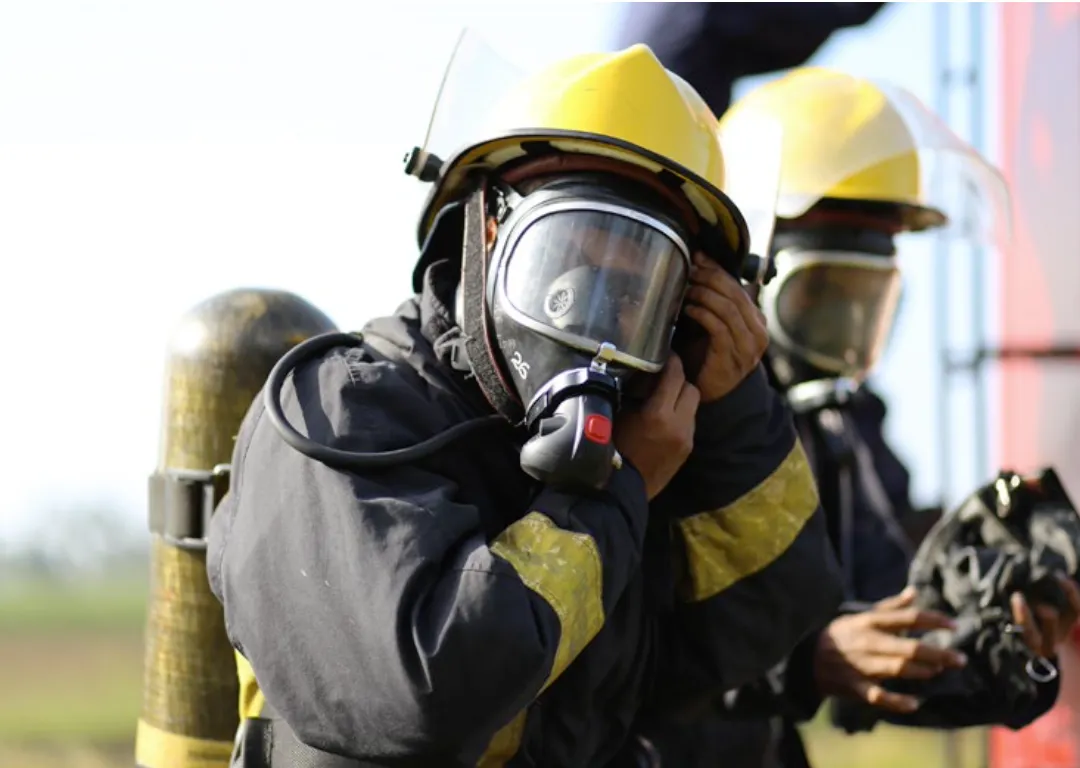
Minimising Risk
If you cannot eliminate the risk, there is a hierarchy of minimisation options.
*See: WorkSafe / What the Hazardous Substances Regulations mean for you
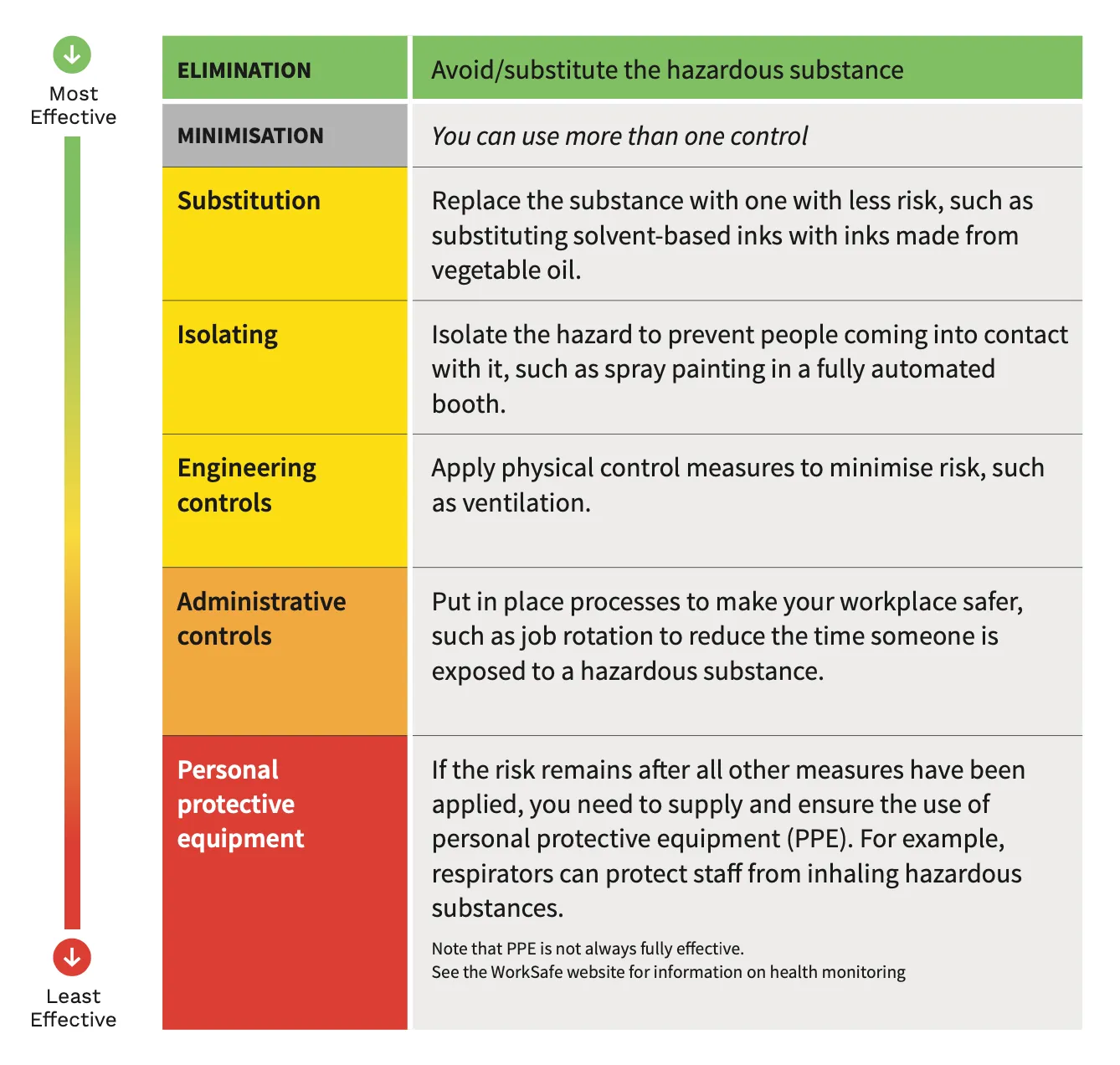
Keeping People Safe
If hazardous substances are used on a production, there are multiple ways you can keep workers and visitors safe.
Inform and Train Workers
Ensure everyone who works with or around hazardous substances has the experience and knowledge to do so safely.
Inform workers of hazardous substances on the production, and the control measures in place during the daily health and safety briefing and place this information on the call sheet.
Label Containers
You need to ensure containers of hazardous substances are always clearly and correctly labelled, this includes:
- substances that have come from a supplier and are therefore already labelled;
- substances that you decant or transfer into a smaller container at your workplace;
- stationary tanks, process containers and transportable containers; and
- hazardous waste.
*See: WorkSafe / Labelling
Install Signs
Place clearly visible signs at entranceways, and on buildings, or in outdoor areas, where substances are used or stored. They should inform people of what hazardous substances are present, the general type of hazard and what to do in an emergency.
*See: WorkSafe / Signs
Store Hazardous Substances Safely
Where and how you store hazardous substances will depend on the type of substance and the amount you have.
The Health and Safety at Work (Hazardous Substances) Regulations 2017 set out the requirements for storing different types, classes and quantities of hazardous substances in different situations.
The MSDS includes handling and storage information about the substance.
*See: WorkSafe / Storage
Plan for an Emergency
If using hazardous substances an emergency plan should be developed, it must:
- address all ‘reasonably foreseeable’ emergencies;
- state any special training needed to deal with an emergency involving each substance;
- include the inventory of hazardous substances present at the workplace;
- include a site plan showing all the hazardous substances locations in the workplace; and
- advise how you will:
- ~ call emergency services
- ~ warn people at the workplace and nearby about the emergency
- ~ advise people how they can protect themselves
- ~ help or treat any one injured in the emergency
- ~ manage the emergency to restrict its effects to the initial area, reduce its severity and if possible, eliminate it.
Fire and Emergency New Zealand (FENZ) can review your plan.
*See: WorkSafe / Emergency plans
Disposal and Recycling
Unused chemicals, and empty chemical containers, are a risk to people, the environment and animals.
You can arrange for unused chemicals to be disposed, or empty containers recycled, through AgRecovery. Information about disposing of products can also on be found on the MSDS.
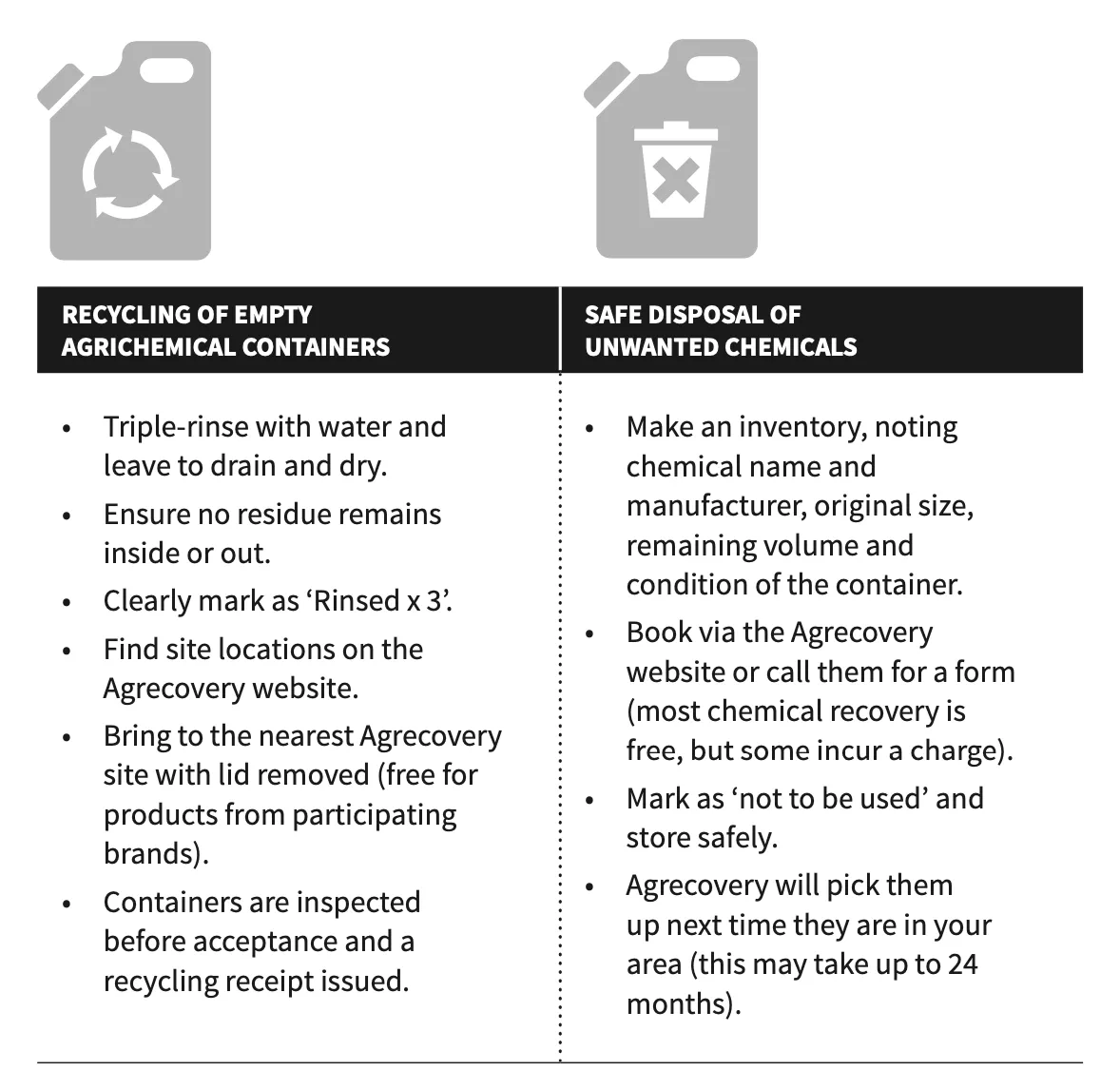
Transport
A certified handler must always be present when explosives are being transported.
Transport of hazardous substances are covered by the relevant transport agency.
Road and rail – the New Zealand Transport Agency
Key points to note:
- Generally, if you're transporting dangerous or hazardous goods, you need a dangerous goods (D) endorsement on your driver licence.
- For transport, dangerous goods are identified with a UN number, a proper shipping name and a diamond-shaped class warning label. Some products also have special marks to warn of hazards that are not indicated by other labels or marks.
- The Land Transport Rule: Dangerous Good 2005 (Rule 45001/1) details how you can transport dangerous goods safely and securely, depending on the nature and quantity of the dangerous goods.
Sea – Maritime New Zealand
Key points to note:
- Controls must be in place to safely manage the hazardous substances.
- An inventory of the hazardous substances you use, handle or store on board must be maintained.
- Anyone who uses or handle hazardous substances must have training to do so.
- The advice on the MSDS must be followed.
- All hazardous substances must be correctly labelled.
- Signs must be displayed to let workers, visitor and emergency service personnel know there are hazardous substances onboard.
Air – Civil Aviation Authority of New Zealand
Key points to note:
- Articles and substances must be properly classified according to a set of standard criteria.
- The packaging used for dangerous goods must meet certain criteria set by the technical instructions.
- The hazards posed by these articles and substances must be identified by markings, package labels and accompanying documentation.
- An airline must have the opportunity to inspect and verify the acceptability of each dangerous goods package as declared by the shipper.
Planning and Guidance Considerations and Responsibilities
Everyone has planning responsibilities for or planning influence over activities that interact with hazardous substances should read and understand this section, as well as the above sections.
This includes funders, the Production Company, Producers, Heads of Department, and Health and Safety Advisors.
Funders
Funders should:
- be assured, through the provision of the production’s health and safety plan, that the funding provided is adequate to provide for competent people to undertake and supervise work with hazardous substances; and
- ensure that all senior contractors have sufficient insurance cover, appropriate to the risk and scale of the work to be undertaken.
Production Company
In pre-production, production companies (likely to have primary responsibility over health and safety on the production) should:
- ensure people who use hazardous substances are competent in their use;
- consider the potential risks associated with hazardous substances when planning and allocating tasks; and
- ensure the potential risks associated are appropriately managed, either eliminating or minimising them.
Producers and Production Managers
As Producers and Production Managers have oversight across the production, they should:
- communicate to all personnel the presence and/or use of hazardous substances;
- provide appropriate information on safety matters should be included;
- ensure workers are provided appropriate personal protective equipment;
- ensure workers are wear appropriate personal protective equipment;
- ensure that emergency and first aid procedures are in place;
- ensure sufficient firefighting equipment is provided and that it is immediately available on set if required; and
- ensure there is a clear access way for emergency and firefighting equipment and vehicles on set.
Heads of Department
As Heads of Department have specific oversight of areas of work that may use hazardous substances for specific task, they should:
- ensure workers using hazardous substances carry the necessary skills, certifications and / or experience;
- ensure hazard identification and risk assessments are undertaken for all activities using hazardous substances, and controls implemented;
- ensure that emergency and first aid procedures are followed;
- ensure personal protective equipment specific for hazardous substance work is provided to, and used by, workers when required;
- communicate to all personnel the presence and/or use of hazardous substances;
- provide appropriate information on safety matters should be included;
- ensure workers are provided appropriate personal protective equipment; and
- ensure workers wear appropriate personal protective equipment.
Health and Safety Officer
The Health and Safety Officer should ensure potential risks associated with hazardous substances are discussed with all cast and crew during health and safety inductions and / or as required if circumstances on the set change.

Training and Knowledge
Hazardous substances must only be used by people with knowledge about the substance, its health effects and emergency procedures.
Substances requiring a controlled substance licence (CSL), such as most explosives, fumigants and VTAs, and acutely toxic (class 6.1A and 6.1B) substances, such as certain pesticides and VTAs, need to be handled by a certified handler.
However, in some cases, people who are not certified handlers can handle substances with certified handler requirements, which are outlined in WorkSafe’s quick guide – certified handler requirements.
To check if you need a certified handler in your workplace, enter your substances into the Hazardous Substances Calculator or search the Environmental Protection Authority’s Approved Hazardous Substances with Controls database.
Anyone handling or working with hazardous substances needs to:
- be trained or supervised in safe handling procedures;
- be provided with information and MSDS about the product;
- understand the physico-chemical and health hazards associated with the hazardous substances;
- understand the procedures for the safe use, handling, manufacture, storage and disposal of the hazardous substances;
- ensure their safety, and the safety of others, when using the hazardous substances;
- understand obligations under the Health and Safety at Work (Hazardous Substances) Regulations 2017; and
- know the actions to be taken in an emergency involving the hazardous substances.
Being a certified handler can help fulfil these requirements.

Hazardous Substances
Who needs to read this?
All workers who undertake work with, or work that interacts with, motor vehicles or drive to work should read and understand the section on ‘minimum responsibilities’.
Roles that have specific responsibilities, or influence, over work with motor vehicles should read the section on ‘planning and guidance considerations’ – this includes producers, directors, production managers, line producers, heads of departments, assistant directors and health and safety officers.
Anyone who operates or is responsible for, or has influence over, a motor vehicle must read and understand all sections of this chapter. This includes drivers of Heavy Motor Vehicles/ Goods Service Vehicles of more than two axles or greater than 3500 kilos manufacturer's gross laden weight, and to drivers of any vehicle carrying more than 10 passengers.
Definitions
Action vehicle means any moving vehicle being used as part of a film sequence.
All-terrain vehicle (ATV) means any vehicle that is principally designed for off-road use. They have three or more wheels, an engine capacity exceeding 50ml and a gross weight of less than 1000kg.
Motor vehicle means any powered vehicle or trailer used on or off the road. Tracking vehicle means a vehicle that is used for the mounting of cameras and
other equipment for photography of, or in, a stationary or moving vehicle.
Specific risks
- Being struck by a vehicle
- Crashes between vehicles and with structures and equipment
- Falls from vehicles
- Fatigue
- Fire
- Exhaust fumes
Minimum Responsibilities
Everyone on a screen production who does, or could, work with motor vehicles, or drives to work, should read and understand this section.
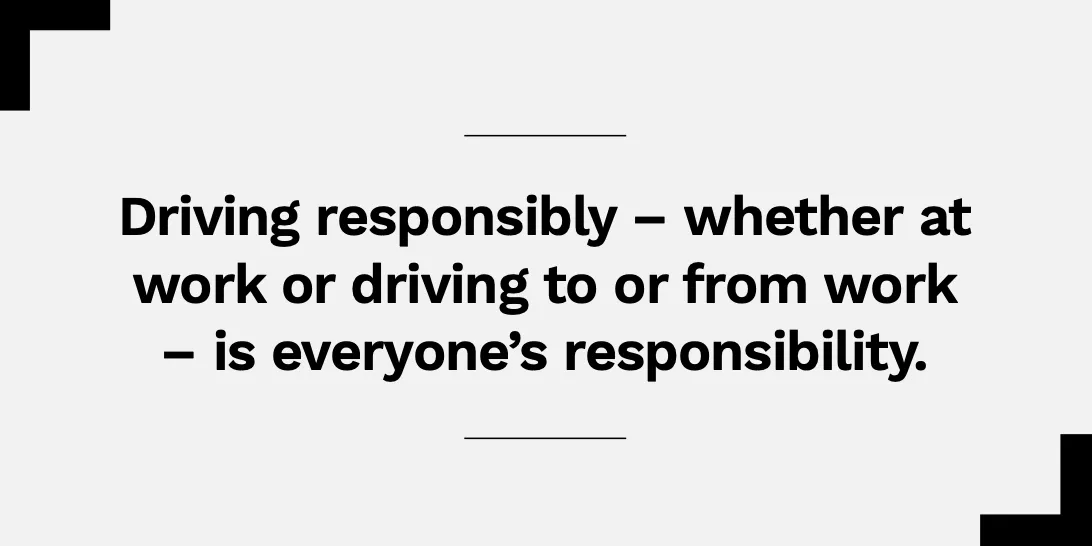
All workers must:
- hold the appropriate license/s for the vehicle/s they drive;
- understand and follow New Zealand laws and regulations relating to motor vehicles and driving;
- understand how fatigue can impact their ability to drive safely and should read the fatigue chapter;
- wear seatbelts, where fitted;
- abide by the alcohol and drugs chapter (link to alcohol and drug chapter); and
- inform the production manager if they lose their license.
Foreign drivers should follow this chapter and can find out more useful information from the NZ Transport Agency.
Planning and Guidance Considerations and Responsibilities
Everyone who has planning responsibilities for or planning influence over activities that interact with motor vehicles should read and understand this section, as well as the minimum responsibilities for everybody.
This includes funders, the Production Company, Producers, persons in charge, and Health and Safety Officers.
Person in charge
The person in charge / those with direct planning responsibilities for or influence over a driver (such as the worker’s superior or the person who hired them) must ensure the driver:
- holds the appropriate license/s for the vehicle/s they drive; and
- abides by the guidelines outlined in the section ‘Responsibilities specific to operating motor vehicles’ below;
- is given, and does not exceed, limitations for driving;
- is given adequate time off; and
- reads and understands the chapter on fatigue.
Funder
Funders should:
- be assured, through the provision of the production’s health and safety plan, that the funding provided is adequate to provide for competent people to undertake and supervise work with motor vehicles.
Production Company / Producer / Production Manager
- Production companies (likely to have primary responsibility over health and safety on the production) must:
- consider the potential risks associated with the use of motor vehicles when planning and allocating tasks;
- ensure the potential risks associated are appropriately managed, either eliminating or minimising them; and
- consider fatigue and workloads involving driving when creating schedules;
- engage competent persons to oversee and undertake work with motor vehicles.
- ensure location and studio driving restrictions are followed – for example a lower speed limit on a studio lot.
Health and Safety Officer
The Health and Safety Officer should ensure potential risks associated with motor vehicles are discussed with all cast and crew during health and safety inductions and / or as required if circumstances on the set change.
Responsibilities specific to operating Motor Vehicles
Anyone who operates or is responsible for, or has influence over, a motor vehicle must read and understand this section, as well as the previous sections, including, but not limited to, drivers of passenger vehicles, Heavy Motor Vehicles and Goods Service Vehicles.
Drivers – all
All drivers must:
- hold the appropriate license/s for the vehicle/s they drive; and
- understand and follow New Zealand laws and regulations relating to motor vehicles and driving – in particular restrictions specific to their type of driver’s license, for example:
- ~learners license;
- ~small passenger service vehicle license;
- ~heavy vehicle license; or
- ~motorcycle license.
All drivers should:
- undertake a safety check of the vehicle and any attachment before each job;
- check the vehicle has a current Warrant of Fitness or Certificate of Fitness or Permit to Operate;
- check heavy vehicles’ road user charges (RUC) are up-to-date;
- read and understand the section below on tracking vehicles, action vehicles, and/or all-terrain vehicles if relevant to their role as a driver;
- not exceed legal, or recommended, driving limitations; and
- have adequate time off duty.
Person in charge
The person in charge of those operating motor vehicles – such as a direct supervisor or the person who hired the worker – on or around the production should ensure:
- drivers have adequate time off duty; and
- where possible, that drivers do not exceed driving limitations.
Driving Limitations
It is recommended that all drivers on a production follow the same rules provided by the New Zealand government to drivers of heavy motor vehicles / good service vehicles and small passenger service vehicles.
This means, in any 24-hour period drivers:
- should not drive for more than 11 hours;
- should not drive for more than 5.5 hours continuously, and the minimum break is half an hour;
- should not be at work or be on duty for more than 14 hours
- ~~this includes all working and driving time combined, whether paid or unpaid; "on duty" is defined as any time required to carry out the requirements of the job and includes any other paid employment in which a person is engaged;
- should be off-duty for at least nine hours continuously; ie: from the time a person finishes work at the end of the working day to the time a person starts back at work.
NOTE: There are substantial fines and disqualification penalties for abuse of these rules and they may be imposed on both the driver and the employer.
Tracking Vehicles
Drivers of tracking vehicles should understand and ensure recommendations in this section are followed.
Vehicle-to-Vehicle Shoots
When performing vehicle-to-vehicle shoots, the vehicles should be driven by a driver competent in close moving vehicle driving.
Restricted Access to the Vehicle and Safe Loading
The vehicle should be restricted to essential personnel only and the loading shall be within the safe loading limits of the vehicle.
There should no more people in the vehicle than there are seats with seatbelts.
Public Roads
When filming on or adjacent to public roads a Traffic Management Plan (TMP) must be applied for and approved by the roading authority responsible for
that section of road. TMP's can only be obtained through a registered traffic management company. It is recommended that a traffic management company familiar with filming and events is contracted to provide these services.
When filming on or adjacent to a public road where the driving public may be distracted, the Police should be notified. Adequate warning should be given to other traffic of a tracking vehicle operating. The Traffic Management Company notifies Police if necessary, not the film company.
If on an open road, the overall dimensions of the vehicle should not exceed the dimensions set out by the NZ Transport Agency.
Traffic Controller
When filming on or adjacent to public roads, a designated traffic controller must be engaged, likely by the locations manager, to be responsible for carrying out temporary public traffic control duties as required.
The traffic controller:
- must use appropriate safety equipment and clothing; and
- has the responsibility to stop a shoot if the crew are operating outside of the approved condition of the TMP
Mounting Equipment on the Vehicle
Any equipment attached to a vehicle that is to be driven on a public road must be included in the TMP (see above) and approved of in advance by the issuing authority.
Equipment mounted on the vehicle must be firmly attached to the vehicle.
If using lamps or other equipment running off 230 volt power supply (mains, generator or invertor), lamps must comply to relevant New Zealand regulations and the chapter on electrical safety should be read and followed.
Any rigging on a vehicle must be undertaken by a competent person.
Equipment rigged inside or outside of a vehicle should be secured so as to not harm occupants in an accident.
NOTE: that rigging to outside and/or inside of vehicle may make vehicle safety devices inoperable or more dangerous in case of an incident.
Towing Weight Limitations
The manufacturers limitations on the maximum weight being towed by a vehicle should be complied with.
Safety in Adverse Conditions
Extra consideration should be given to the safety of personnel working on such vehicles in adverse conditions.
Communication between Traffic Controller and Driver
The 1st assistant director or person with delegated responsibility should ensure that adequate communication with the driver and traffic controller is established before any driving takes place.
Warning of Movement of Vehicles
Warning of the movement of vehicles should be given to all crew and cast members in the immediate vicinity of the vehicles.
Dry Run and Authority to Abort
A "dry run" or "walk through" of any action should be conducted prior to rehearsal or filming with all personnel involved present. An understanding of any intended action, possible deviations and authority to abort, should be made clear to all concerned.
Action Vehicles
The appropriate person in charge, for example the stunt or vehicle coordinator, must ensure action vehicles:
- are only be used under the control of a competent person; and
- whether independently mobile or not, are appropriate for the task for which it is to be used.
All-Terrain Vehicles
All-terrain vehicles (ATVs) include quad bikes, smaller ‘side-by-sides’ and amphibious vehicles.
On Road
When using ATVs on roads, drivers, and the person in charge, must ensure:
- the ATV is registered and licensed;
- the ATV has a current warrant of fitness (except if used as a farm vehicle);
- the driver holds a current New Zealand driver licence;
- the manufacturer’s recommendations for passengers and loading are followed
- ~~ there should only ever be one person on a quad bike; and
- the driver, and any passengers, wears an approved safety helmet.
Off Road
An ATV that is never used on a road does not need to be registered or licensed.
When using ATVs off roads, drivers, and the person in charge, must ensure:
- the manufacturer’s recommendations for passengers and loading are followed
- ~~there should only ever be one person on a quad bike; and
- the driver, and any passengers, wear an approved safety helmet.
For more information about ATV requirements visit the NZ Transport Agency website.
Recommended Reading
- Quads bikes and ATVs, NZTA
- Safe filming and recording in, from and around vehicles, HSE
- Vehicles: recording in, from and around, BBC
- Guidelines to filming on the move, Metropolitan Police

Motor vehicles – Restrictions
Noise Management
This chapter provides guidance in relation to noise, and is primarily based on New Zealand legislation and guidance issued by WorkSafe NZ.
Who needs to read this?
All workers who undertake tasks where they are, or could be, exposed to excessive noise should read and understand the section on ‘minimum responsibilities’.
Roles that have specific responsibilities, or influence, over workers who are, or could be, exposed to excessive noise should read the section on ‘planning and guidance considerations and responsibilities’ – this includes producers, directors, production managers, line producers, heads of departments, assistant directors and health and safety officers.
Definitions
Audiometry6 means the measurement of the hearing threshold level of a person by means of a bilateral pure tone air conduction threshold test.
Excessive noise, for the purpose of this document, is noise that is at or above the following levels—
~(1) eight-hour equivalent continuous A-weighted sound pressure level, LAeq,8h of 85 dB(A); and
~(2) a peak sound pressure level, L-peak, of 140 dB —whether or not the individual is wearing a personal hearing protector; or
~(3) if the threshold is lower, the levels defined in the Health and Safety at Work 2016 Regulations. Note: these Regulations are due to be updated and the noise threshold may be lowered.
Hearing protector means a device or pair of devices that have been tested to an appropriate national or international standard and classified (or graded) by a suitably equipped and independently audited laboratory with full trace ability to National Standards. Such a device is worn by a person or inserted in the ears of a person to protect that person from exposure to noise.
Impulse noise means noise consisting of a single pressure peak, or a sequence of such peaks, or a single burst with multiple pressure peaks, or a sequence of such bursts.
Noise means any sound which is present in the place of work whether it is wanted or not wanted, and includes sound energy of any frequency, whether or not capable of being perceived by the unaided human ear.
Noise induced hearing loss is hearing loss that occurs due to excessive noise exposure; it can be identified by deterioration in hearing, a loss excessive for age, or a noise pattern discovered during audiometric testing.
What we need to know about noise
Excessive noise, both short but extremely loud noise (impulse noise) and prolonged continuous noise, can cause noise induced hearing loss.
Exposure to excessive noise can also trigger workplace stress, causing anxiety or psychological harm, as well as headaches, fatigue and decreased concentration, increasing the risk of accidents. Excessive noise and noisy processes are also often associated with vibrations, which can impact a worker's health.
Excessive noise exposure can also prevent people from hearing alarms or warning signals, limiting awareness and potentially leading to avoidable accidents.
How can I tell what excessive noise is?
Daily exposure to noise above 85 decibels (dBA) will damage hearing; however, 85dBA might not mean a lot to most people.
Excessive noise, or a noise hazard, probably exists if:
- you have difficulty understanding what's being said one metre away;
- you have ringing in your ears (tinnitus) after exposure to the noise;
- or your hearing seems muffled after leaving a noisy area.
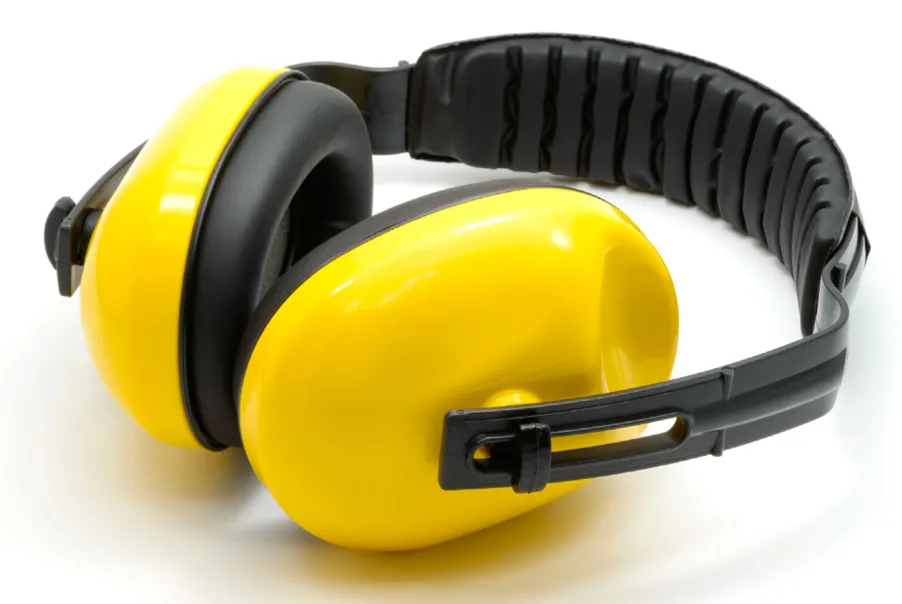
Example of noise levels are outlined below:
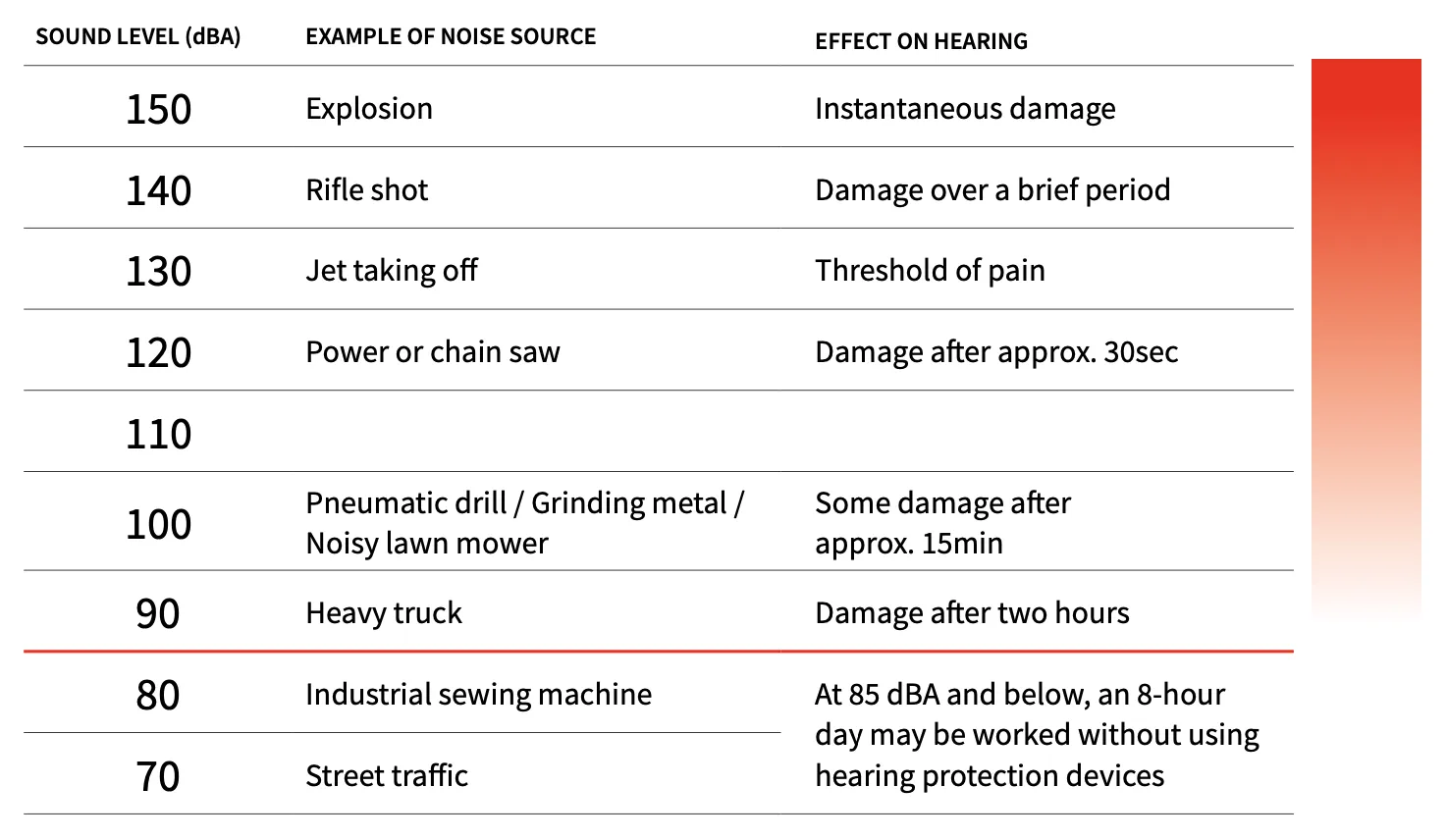
Minimum responsibilities – everyone!
Everyone who undertakes tasks where they are, or could be, exposed to excessive noise should read and understand this section, as well as the section above on ‘what we need to know about noise’.
Anyone who is responsible for, or has influence over, workers who are, or could be, exposed to excessive noise should also read and understand the following section on ‘planning and guidance considerations and responsibilities’.
All workers should:
- understand the risks associated with working in noisy environments;
- follow all procedures and controls put in place to keep themselves and others safe when working in noisy environments;
- use personal hearing protective devices when required, and ensure they are worn correctly;
- read the section later in this document on personal hearing protective devices;
- understand the noisy activities outside of work that can negatively impact on their hearing, such as listening to loud music or undertaking noisy tasks like mowing the lawn or using power tools at home; and
- advise their supervisor or the health and safety officer if they are concerned about the level of noise they, or others, are exposed to.
* See the Hearing Protection Guidebook from Worksafe
Planning and guidance considerations and responsibilities
Anyone who is responsible for, or has influence over, workers who are, or could be, exposed to excessive noise should also read and understand this section, as well as the minimum responsibilities for everyone.
This includes the production company, producers, directors, line producers, heads of departments, assistant directors and health and safety officers, who must consult, cooperate and coordinate with other PBCUs whose work may create, or be impacted by, excessive noise.
Everyone who is responsible for, or has influence over, an activity or task which creates, or is impacted by, excessive noise should:
- consider the risks associated with noise when planning and allocating tasks; and
- manage the risks associated with excessive noise, either eliminating or minimising them.
Identifying excessive noise
Everyone who is responsible for an activity or task in relation to the production should consider the risks associated with excessive noise.
Preliminary Noise Assessment
A preliminary noise assessment is often called a walkthrough survey. It is a screening tool, which will help identify probable or possible excessive noise and should highlight which tasks, processes or areas in the workplace require a detailed noise assessment.
Anyone can undertake a preliminary noise assessment – see appendix A below for an example of a checklist.
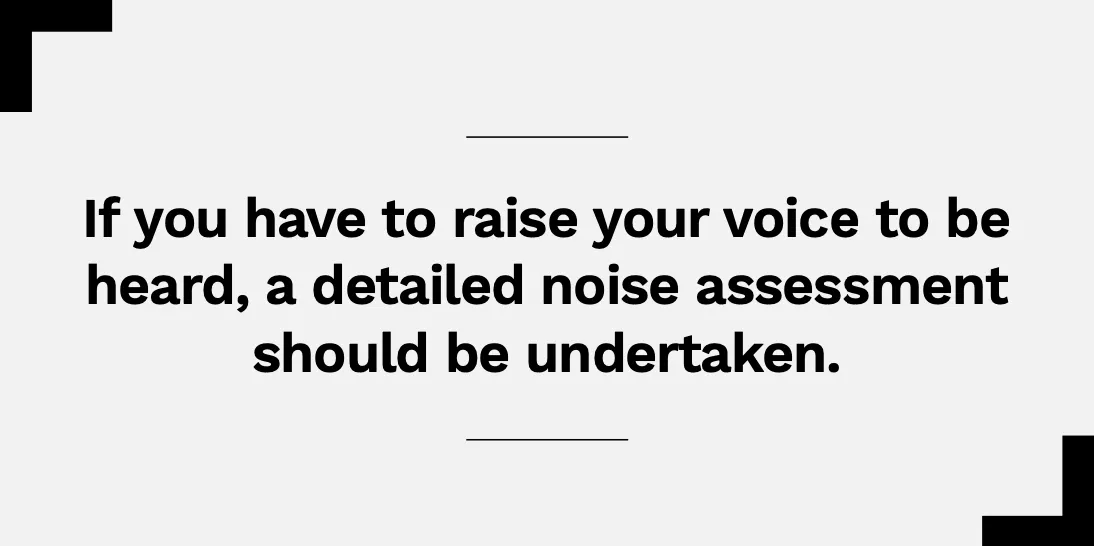
Detailed Noise Assessment
A detailed noise assessment will determine if the workplace contains noise that exceeds the exposure limits, and is required when:
- complex noise sources are present;
- if there is doubt over the noise levels – raised by the PCBU or workers; or
- if a preliminary noise assessment raises doubt over the noise levels.
A detailed noise assessment will:
- quantify the amount of noise workers are exposed to;
- help identify the noise source;
- assist in developing control solutions; and
- determine if hearing protection devices are required.
A detailed noise assessment must be undertaken by a competent person.
Further information can be found in Management of noise in the workplace - Approved Code of Practice (ACOP).
Hearing conservation programme
As soon as a PCBU is aware that workers are being exposed to noise that exceeds exposure limits, they must put in place a hearing conservation programme, which includes determining if hearing protection devices and hearing protection areas are required.
For more information about what needs to be considered as part of a hearing conservation programme refer to the Noise in the workplace – Approved Code of Practice (ACOP).
Hearing Protection Areas
Hearing protection areas are workspaces that have, or may have, excessive noise, where hearing protection devices must be worn, even if a worker or visitor is only in the area for a short amount of time.
These areas must be identified, with the areas and machinery concerned clearly labelled. The PCBU may wish to put up signs.
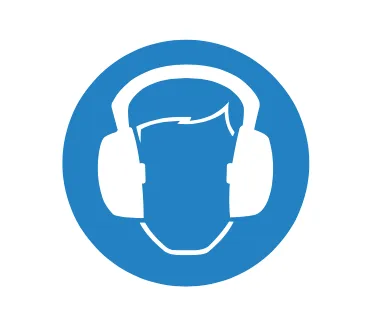
If signs are not practicable, the PBCU must work with workers to come up with other ways of informing both workers and visitors on set that they must wear hearing protection devices. This could include:
- warning notices;
- instructions on call sheets or during inductions; or
- specific supervision in areas with excessive noise.
The requirements for hearing protector areas are detailed in clause 10 Hearing protector areas of AS/NZ 1269.3
or you can read about them in part 6.4 (pg 23-24) of Approved Code of Practice (ACOP).
Managing the risk
Elimination is the most effective control method; you do this by completely removing or avoiding the possibility that someone will be exposed to excessive noise – 85dBA a day or a peak sound pressure level, Lpeak, of 140 dB.
If complete elimination is not reasonably practicable, you must consider ways to minimise the risk so workers are not exposed to excessive noise.
There are two primary ways to minimise, or control, excessive noise – at the source or by isolating either the source or the worker.
You can control the source of the noise by:
- purchasing equipment with the lowest noise rating;
- ensuring that, where reasonably practicable, machinery is installed with vibration isolators to reduce noise; or
- ensuring that equipment is properly maintained and operated.
Controlling noise at the source is best achieved at the planning stage; you can do this by:
- increasing the distance between the noise source and the exposed person;
- placing barriers between the noise source and the exposed person; or
- decreasing the time the at-risk person is exposed to the noise.
If you cannot reduce noise exposure to less than 85dBA a day, the final option is to minimise the risk using suitable hearing protection.
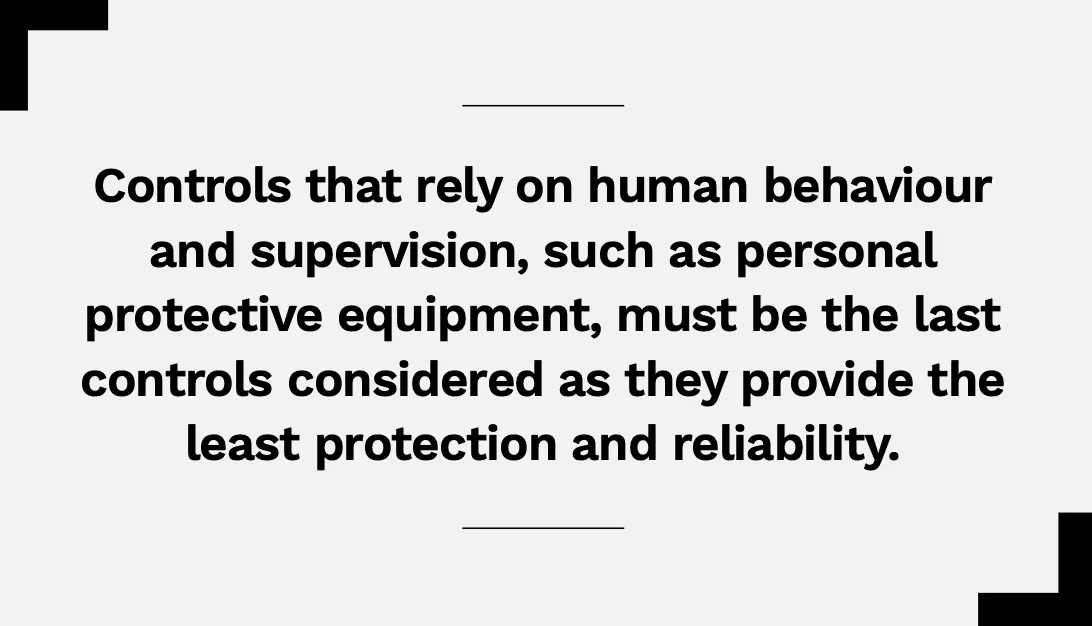
Hearing protection devices
If you cannot reduce the noise to a safe level for workers, you must ensure workers have suitable hearing protection devices (HPDs); the worker is responsible for using them appropriately.
Areas where HPDs must be worn must be designated hearing protection areas and, where practicable, signposted indicating that HPDs must be used.
The main types of HPDs are ear muffs and earplugs; either type can provide effective protection provided it makes an airtight seal in (plugs) or around (muffs) your ear.
The head of department, or equivalent supervisor:
- must ensure all HPDs are manufactured to a recognised Standard and must be the correct grade for the noise level encountered;
- should let the worker choose what HPD to use, providing it gives adequate protection;
- should ensure HPDs are clean and in a good state of repair.
It is important that hearing protectors fit correctly.
For more information about choosing and maintaining HPDs refer to the Noise in the workplace - Approved Code of Practice (ACOP).
See also - Hearing Protection (Worksafe booklet)
Training and Education
All workers should be trained in the selection, fitting, use, care and maintenance of HPDs.
Health and safety inductions should include an explanation about the risk that removing HPDs can have to an individual’s hearing.
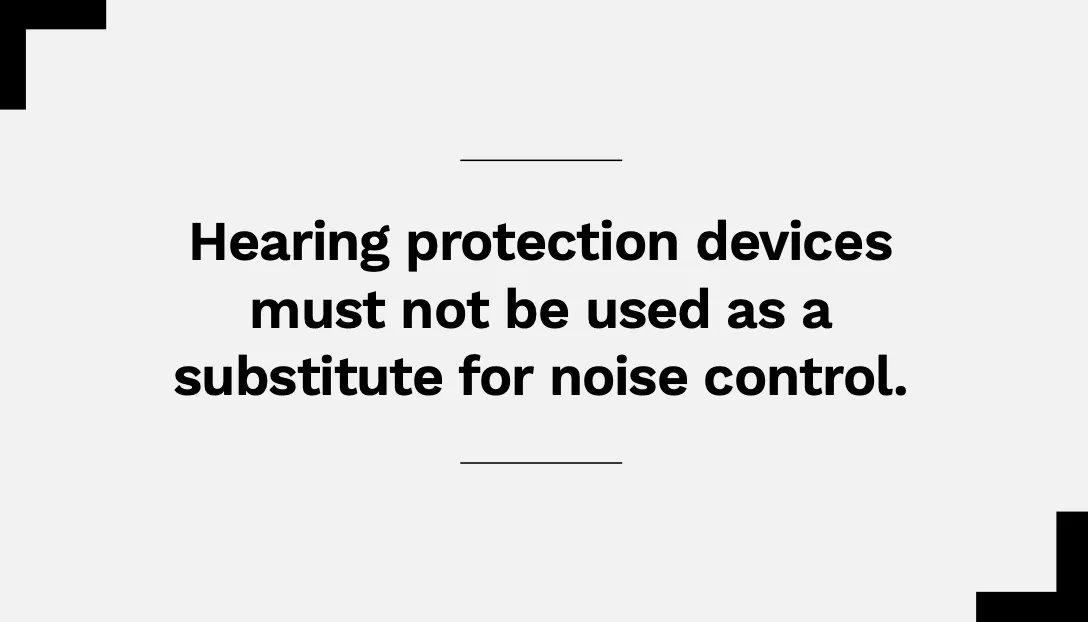
Monitoring the risk
During the production, workers’ exposure to noise should be monitored to ensure they are not being exposed to excessive noise.
If noise does exceed exposure limits, the PCBU must put in place a hearing conservation programme and may consider carrying out audiometric testing.
For more information refer to the Noise in the workplace - Approved Code of Practice (ACOP).
Funders
Funders should:
- be assured, through the provision of the production’s health and safety plan, that the funding provided is adequate to provide HPDs.
Production Company
In pre-production, production companies (likely to have primary responsibility over health and safety on the production) should:
- ensure workers’ exposure to noise to monitored; and
- ensure a hearing conservation programme is put in place.
Producer / Line Producer / Production Manager
As Producers and Production Managers have oversight across the production, they should:
- consider the potential for exposure to excessive noise when planning and allocating tasks;
- ensure the potential for exposure to excessive noise is either eliminated or minimised;
- ensure workers’ exposure to noise to monitored;
- ensure a hearing conservation programme is put in place;
- ensure information about hearing protection areas and the requirement for HPDs is included on daily call sheets.
Director
Directors should:
- consider the potential for exposure to excessive noise when planning and allocating tasks; and
- ensure the potential for exposure to excessive noise is either eliminated or minimised.
Heads of Department
Heads of Departments should:
- consider the potential for exposure to excessive noise when planning and allocating tasks;
- ensure the potential for exposure to excessive noise is either eliminated or minimised;
- ensure information about hearing protection areas and the requirement for HPDs is discussed at team meetings;
- let the worker choose what HPD to use, providing it gives adequate protection; and
- ensure HPDs are clean and in a good state of repair.
They must also ensure all HPDs are manufactured to a recognised Standard and are the correct grade for the noise level encountered. See the Approved Code of Practice.
Assistant Director/s
The Assistant Director/s should:
- ensure risks associated with excessive noise are discussed with all cast and crew during health and safety inductions and / or as required if circumstances on the set change; and
- report incidents of noise-related injury – notifiable event.
Health and Safety Officer
The Health and Safety Officer should:
- ensure risks associated with excessive noise are discussed with all cast and crew during health and safety inductions and / or as required if circumstances on the set change;
- explain the risk that removing HPDs can have to an individual’s hearing; and
- report incidents of noise related injury – notifiable event.
References
- Health and Safety in Employment Regulations 1995
- Occupational Health and Safety Service, Department of Labour (now WorkSafe New Zealand); A Message to Employers on Preventing Hearing Loss
- Occupational Health and Safety Service, Department of Labour (now WorkSafe New Zealand); Management of noise in the workplace – Approved Code of Practice (ACOP)
- Occupational Health and Safety Service, Department of Labour (now WorkSafe New Zealand); Management of Noise at Work - Control Guide (1996)
- ACC - Occupational Noise Levels
Appendix 1: preliminary noise assessment checklist
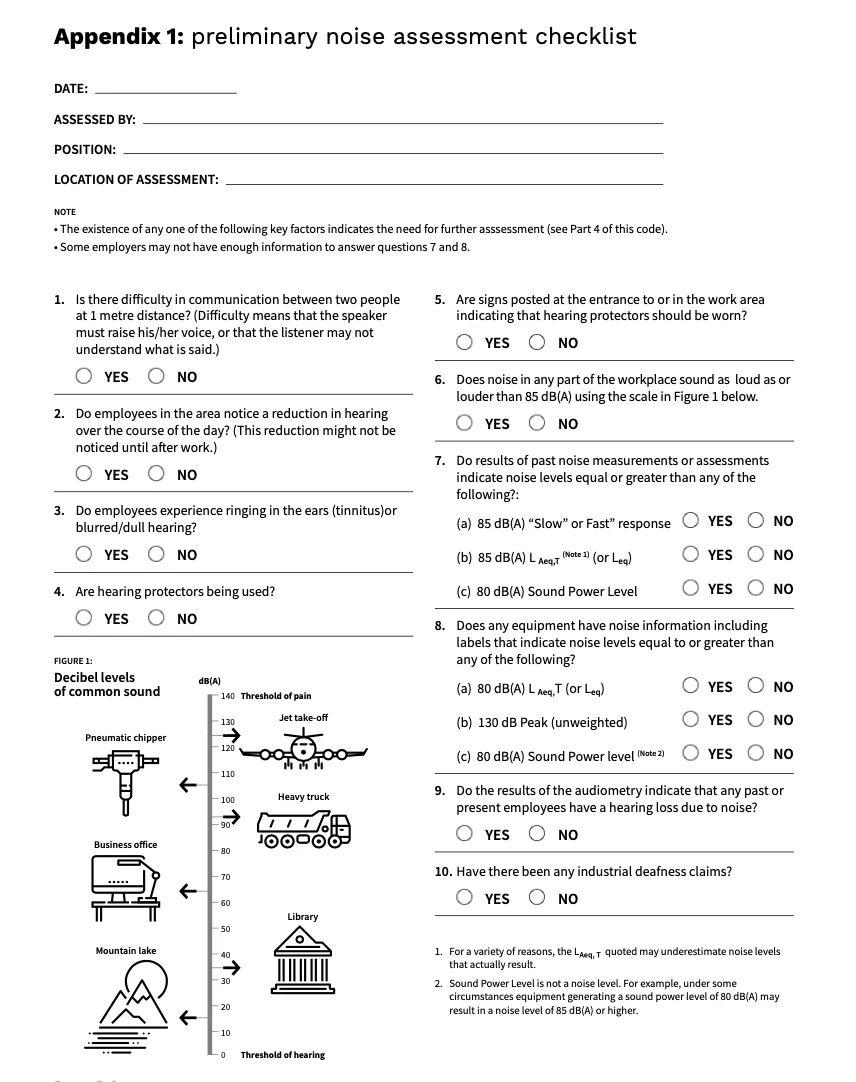
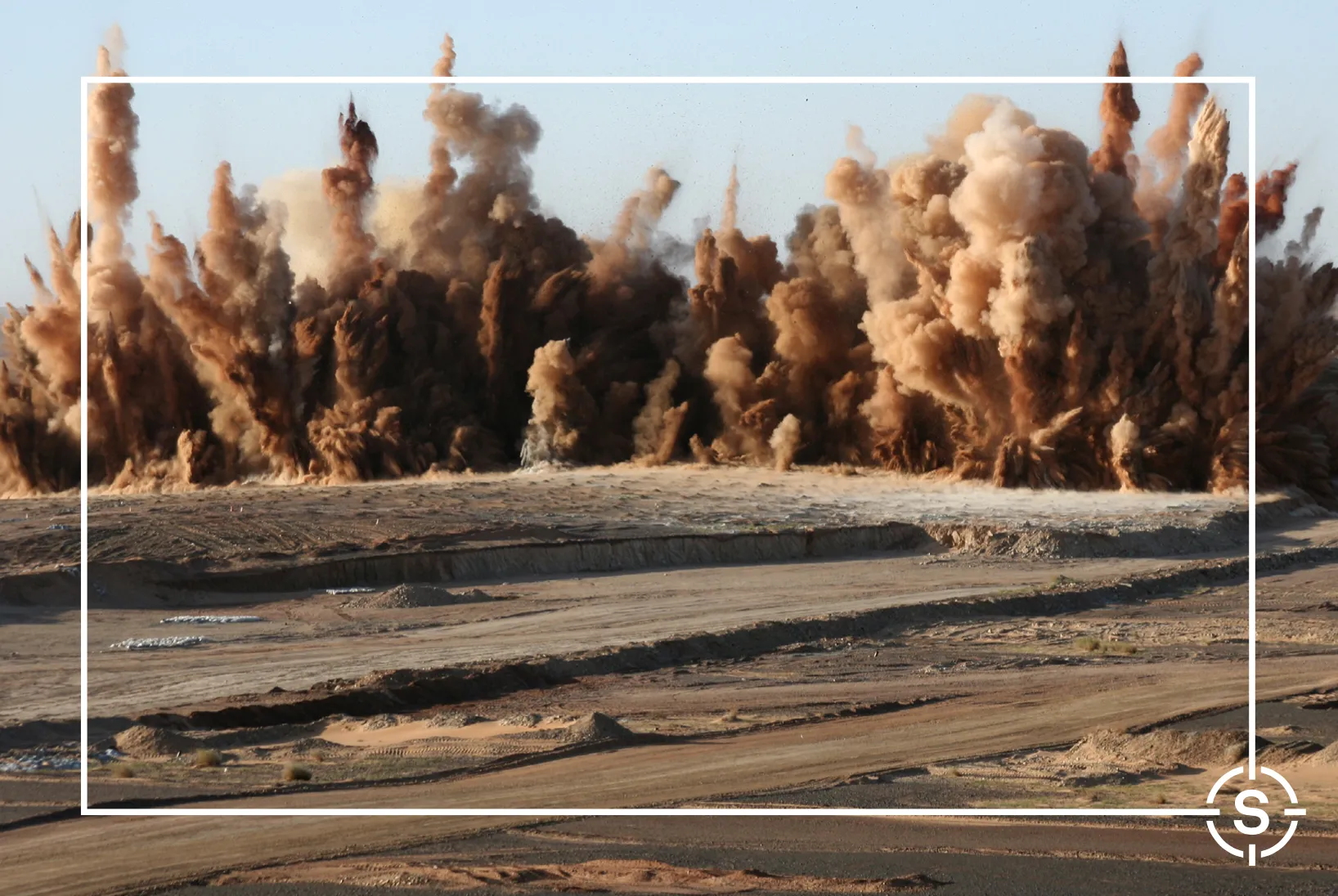
Noise Management
Who needs to read this?
Anyone involved in tasks that could lead to OOS (such as repetition), as well as those responsible for engaging staff to perform repetitive tasks on a production.
Roles that have direct influence over other workers should also read the ‘planning and guidance considerations’ section; this includes production company representatives, Producers, Directors, Production Managers, Heads of Department, Assistant Directors, Health and Safety Officers and Location Managers.
Definitions
OOS (Occupational Overuse Syndrome) or RSI (Repetitive Strain Injury) are terms used to describe a variety of conditions, including injury from discomfort. In accordance with WorkSafe New Zealand’s definition, OOS is characterised by discomfort or persistent pain in muscles, tendons and other soft tissues.
Symptoms
OOS is different to the type of pain associated with muscle pain and soreness after exercise, activity the body is not accustomed to, or other conditions such as arthritis.
Early symptoms of OOS may include:
- muscle discomfort
- fatigue
- aches and pains
- soreness
- hot and cold feelings
- muscle tightness
- numbness and tingling
- stiffness
- muscle weakness
Causes
OOS often occurs over time, and is normally caused or aggravated by specific types of work. The condition can also be created or made worse by activities away from the workplace.
Work that may result in OSS often involves repetitive movement, sustained or constrained postures, and/or forceful movements. It may also be provoked by other factors such as stress and working conditions. While some conditions of OOS are well understood medically, many are not and the cause of them is yet to be determined.
Prevention
Ensuring workers are provided a variety of tasks and regular rest breaks are believed to be the best preventative measures for OOS, as the absence of these is thought to strain muscle and tendons beyond their ability for short-term recovery.
High-Risk Roles
Some roles or tasks in the screen industry affected by OOS include:
- cleaners (studio and office cleaners)
- machinists (grips/riggers/set construction/camera department/art department)
- kitchen workers (craft service)
- typists (producers, assistants, production office)
- painters (set painters)
- hairdressers (hair and makeup)
- carpenters
- operators (camera, camera crane)
Minimum Responsibilities
Everyone involved in a screen production who undertakes tasks that could put them at risk of OOS should read and understand this section.
All workers should:
- read the above sections on definitions, symptoms, causes and prevention;
- understand the risk associated with activities that can lead to OOS; and
- inform their head of department if their workspace set up is not adequate.

Planning and Guidance Considerations and Responsibilities
Everyone who has responsibilities, or influence over, an activity or task that may result in OOS should read and understand this section, as well as the minimum responsibilities for everybody.
Prevention
The best way to avoid the consequences of OOS is through prevention rather than cure. Preventing OOS can be addressed through:
- design of equipment and tasks;
- organisation of work;
- work environment;
- training and education; and/or
- development of policies.
Roles and Responsibilities
Funders
Funders should:
- be assured, through the provision of the production’s health and safety plan, that the funding provided is adequate for the proposed length of the production process; and
- incorporate health and safety clause/s in the funding agreement.
Production Company
In pre-production, production companies (likely to have primary responsibility over health and safety on the production) should:
- ensure necessary planning is done to minimise risk of OOS occurring; and
- ensure senior staff hired are aware of OOS prevention.
Producer / Production Manager
In pre-production, the Producer / Production Manager should ensure:
- /adequate design of workstations and equipment;
- each person’s workstation is appropriately setup to minimise the risk of OOS;
- the number of people hired is in relation to the size of the project;
- there is enough variety of tasks in the organisation of work;
- enough people are hired to allow everyone appropriate rest breaks;
- staff are aware of ways to prevent OOS and provide any training or education on this where required; and
- sufficient resources, including budget, are allocated to enable appropriate and safe environments and working practices.
Director / Heads of Department
The Director and all Heads of Department should:
- be aware of the risk of OOS to their respective teams; and
- take steps to provide adequate workspaces, appropriate rest breaks and a variety of tasks where possible to minimise the risk of OOS developing.
Health and Safety Officer
The Health and Safety Officer should:
- work with the Producer, Production Manager and Heads of Department to help them assess workspaces that may present a risk for OOS; and
- ensure the potential for any OOS arising is discussed with cast and crew during health and safety inductions and / or as required if circumstances change.
Training
- Workers should be made aware of OOS during their health and safety induction.
References
The following were used as reference in the research and development of these guidelines:
NZ Technician’s Guild Safety Code of Practice (SCOP)
http://screensafe.co.nz/pdf/Technical Guidelines for ScreenSafe.pdf


Occupational Overuse Syndrome
Workplace bullying
This chapter provides guidance on the prevention and response to bullying in the New Zealand screen industry.
This chapter is primarily based on guidance issued by WorkSafe New Zealand.
Introduction
This chapter provides guidance on the prevention and response to bullying in the New Zealand screen industry, from the initial concept for the film, television show or advertisement, to casting, production, post production through to the final delivery of the project.
Everyone involved in the screen industry is responsible for creating an environment where individuals are treated with respect and dignity.
Bullying during any stage of a production can have serious effects on the health and safety, and the overall performance, of workers.
Bullying is unacceptable both morally and legally – as outlined in the Health and Safety at Work Act 2015.

Who needs to read this?
All workers on a production have a legal duty to ensure health and safety legislation, regulations and guidelines are followed, and are directly responsible for their individual conduct.

Anyone working within or with the screen industry, including those responsible for engaging with talent and crew on a production, should follow these guidelines.
Roles that have direct influence over other workers should also read the ‘planning and guidance considerations and responsibilities’ section; this includes production company representatives, casting agents, agents, cast, producers, directors, production managers, heads of departments, assistant directors, health and safety officers, and location managers, along with any other crew and all other contractors.
Definitions
Workplace bullying, as defined by WorkSafe New Zealand, is repeated and unreasonable behaviour directed towards a worker or group of workers that can lead to physical or psychological harm.
What we need to know about workplace bullying

* Find out more about what workplace bullying is, and is not, on the WorkSafe New Zealand website.
Discussion between workers, even when there are different ideas / disagreement of ideas, can be useful if it promotes new solutions and ideas; however, this needs to be observed as it could escalate to bullying.
When Can Bullying Occur?

Bullying could:
- be between managers and workers, or co-workers, or workers and visitors on set;
- occur at any time;
- be carried by one or multiple people;
- be directed at one or multiple people;
- occur outside of work hours.
Bullying can be carried out in person, by email, text messages, internet chat rooms or other social media channels.
How to Identify Workplace Bullying – what Kind of Behaviour Can Be Perceived as Bullying?
Bullying can be physical, verbal or relational / social (such as excluding someone from a peer group or spreading rumours).
Common bullying behaviours fit into two main categories:
1. Attacks that are direct and personal
- such as belittling remarks, silent treatment, attacking a person’s beliefs, race, gender, gender identity, sexual orientation, lifestyle or appearance, threats of violence, humiliations, intimidation, unwanted sexual approaches, verbal abuse; or
2. Attacks that are indirect and task related
- such as impossible deadlines or tasks, meaningless tasks, withholding information, constant criticism of work, underwork, unreasonable monitoring, no support from manager, scapegoating.
Minimum responsibilities for everyone
Everyone involved in a screen production should read and understand this section.
Everyone involved in a production should have read the section on ‘what we need to know about workplace bullying’ above and:
- understand what workplace bullying is;
- understand how to identify workplace bullying; and
- ensure they advise the health and safety officer, their direct supervisor, the assistant directors, and/or the production manager/office if they become aware of bullying.

* Download the "Bullying at Work: Advice for Workers - Quick Guide" by clicking the image below.

* For more detail on roles and responsibilities regarding workplace bullying see section 3.8 of WorkSafe New Zealand’s Good Practice Guide ‘Preventing and responding to bullying at work’.

Planning and Guidance Considerations and Responsibilities
Everyone who is responsible for, or has influence over, an activity or task in relation to a production should read and understand this section, as well as the minimum responsibilities for everybody.
This includes funders, production company representatives, directors, producers, production managers, line producers, heads of department, assistant director/s and health and safety officers. All of whom should follow the guidance provided in the below sections on assessing the risk and managing the risk, as well as the section for their specific role.
Assessing the Risk

How Can You Tell if Bullying is Occurring?
Anyone who is responsible for an activity or task in relation to a production should understand what workplace bullying is, when it may occur and
know how to identify it.
We are all responsible for taking reasonable care of our own health and safety and ensuring that our actions, or inactions, do not harm others – including understanding bullying.
A good starting point to tell if bullying is occurring is to look at, but not limited to:
- unexpected turnover of workers;
- unexpected absenteeism – sick leave;
- formal complaints / reports of unreasonable behaviour;
- worker interviews / focus groups; or
- feedback from workers or/or health and safety representatives.
* Detailed information can be found in tables 4 and 5 in section 2 of WorkSafe New Zealand’s Good Practice Guide ‘Preventing and responding to bullying at work’.
Managing the risk

Bullying
It is unlikely you will ever be able to completely eliminate bullying; however, you must, so far as is reasonable, minimise the likelihood of bullying by putting in control measures and effectively managing it when it does occur.
You can help minimise bullying by:
- building good relationships in a respectful work environment;
- developing good managers;
- educating workers about bullying;
- making sure your workers know how to report unreasonable behaviour;
- making sure everyone knows their responsibilities;
- making your anti-bullying policies, processes and systems transparent; and
- providing support to workers who experience unreasonable behaviour.
This could include having a code of conduct – for an example see the NZ Police Code of Conduct: https://www.police.govt.nz/about-us/publication/new-zealand-police-code-conduct

* Detailed information about how you can minimise bullying can be found in section 3 of WorkSafe New Zealand’s Good Practice Guide ‘Preventing and responding to bullying at work’.
ScreenSafe highly recommends everyone who is responsible for, or has influence over, an activity or task in relation to a production read this section.
Investigating Bullying

Quick Guide ‘Preventing and responding to bullying at work: Advice for small businesses’
The below flow chart can help you decide what approach to take.


Detailed information about who can help in cases of bullying can be found in section 6 of WorkSafe New Zealand’s Good Practice Guide ‘Preventing and responding to bullying at work’. This section outlines relevant legislation and external parties who can help you and / or your workers.
Workplace Anti-bullying Policy
Consider developing an anti-bullying policy to sit alongside your health and safety policy.
The policy should:
- define bullying;
- state what will be done on the production to minimise the risk of bullying;
- outline workers responsibilities;
- outline procedures for reporting bullying risks; and
- outline procedures for managing bullying.
* An anti-bullying policy template can be found HERE
Responsibilities
Funders
Funders should:
- incorporate anti-bullying clauses, such as implementing an anti-bullying policy, in the funding agreement.
Production Company
The production company (likely to have primary responsibility over health and safety on the production) should develop an anti-bullying policy.
Producer / Production Manager / Line Producer / Director / Heads of Department
As positions with oversight across the production, Producers, Production Managers, Line Producers, Directors and Heads of Departments should:
- understand how to identify bullying;
- minimise bullying as far as is reasonably practicable, following the guidelines outlined in ‘managing the risk’;
- investigate any claims of bullying.
Assistant Director/s
The Assistant Director/s should:
- understand how to identify bullying and the processes for dealing with bullying.
Health and Safety Officer
The Health and Safety Officer should:
- work with Producers, Production Managers, Line Producers, Directors and Heads of Departments to help identify and investigate bullying.
Who can help?
Acts of violence should be reported to the Police as soon as possible; this could be verbal (verbal abuse, threats, shouting, swearing) or physical (stalking, throwing objects, hitting, damage to property).
As outlined in WorkSafe’s quick guide “Bullying at Work: Advice for Workers”, help and advice may be found from places like:
- WorkSafe, as New Zealand’s primary health and safety regulator: 0800 030 040 (24 hours)
- Human Rights Commission (for complaints about discrimination): https://tikatangata.org.nz
- Community law centres: http://communitylaw.org.nz
- The Citizens Advice Bureau: www.cab.org.nz
- Helplines such as Lifeline 0800 543 354, Samaritans 0800 726 666 and Healthline 0800 611 116 (for more information see: www.mentalhealth.org.nz/get-help/in-crisis/helplines)
- NetSafe (for cyberbullying): www.netsafe.org.nz/what-is-cyberbullying

Workplace Bullying
Harassment is a known workplace risk and managing this risk must be a standard part of every productions approach to effective management of health and safety.
Everyone involved in the screen industry is responsible for creating an environment where individuals are treated with respect and dignity. The people in charge of productions have a duty to ensure you feel safe to raise your concerns about harassment. If you see or experience harassment – you need to speak up. It might be scary, but it is one way we will stop harassment infiltrating our productions.

ScreenSafe is working with other committed groups and individuals to put in place clear guidelines and suggested processes for productions to follow to minimise harassment on productions. In the meantime, below is some key information you should know about harassment.
Introduction
Harassment at any stage of production can have serious effects on the health and safety, and the overall performance, of cast and crew. Harassment is unacceptable both morally and legally – workers are protected from both racial and sexual harassment under the Human Rights Act 1993 and Employment Relations Act 2000. Other relevant legislation includes the Health and Safety at Work Act 2015 and the New Zealand Bill of Rights Act 1990.
Definitions
Harassment is unwanted and unwarranted behaviour that a person finds offensive, intimidating or humiliating and is repeated, or significant enough as a single incident, to have a detrimental effect upon a person's dignity, safety and well-being.
Racial harassment is uninvited behaviour, language (written or spoken), or visual material that humiliates, offends or intimidates someone because of their race, colour, or ethnic or national origin.
- directly or indirectly asking for sex, sexual contact or other sexual activity, with a promise (it can be implied) of better treatment in their work, or a threat (it can be implied) either of worse treatment or about current or future job security by:
- subjecting (either directly or indirectly) the worker to behaviour that they don’t want or is offensive to them (even if they don’t let the harasser know this) and which either is so significant or repeated that it has a negative effect on their work, job performance or job satisfaction:
- by using (in writing or speaking)sexual language, or
- by using sexual visual material (eg pictures, diagrams, photos, videos, etc), or
- through sexual physical behaviour.
- subjecting (either directly or indirectly) the worker to behaviour that they don’t want or is offensive to them (even if they don’t let the harasser know this) and which either is so significant or repeated that it has a negative effect on their work, job performance or job satisfaction:
What we need to know about Workplace Harassment
What is Harassment?
"...unwanted and unwarranted behaviour that a person finds offensive, intimidating or humiliating and is repeated, or significant enough as a single incident, to have a detrimental effect upon a person's dignity, safety and well-being" - Hadyn Olsen, Workplace Trainer

Harassment can be a one-off occurrence or repeated and ranges from behaviour that causes slight embarrassment, through to criminal acts including:
- a generally "hostile" work atmosphere of repeated put-downs, offensive stereotypes, malicious rumours, or fear tactics such as threatening or bullying;
- a general work atmosphere of repeated jokes, teasing, flirting, leering or sleazy "fun";
- an isolated but significant incident, such as a violent attack or sexual assault; or
- comments or behaviour that express hostility, contempt or ridicule for people because of race, age, gender, sexuality or beliefs.
The person doing the harassment doesn’t have to be intending to harass for the behaviour to be harassment, it depends on how the person the behaviour impacts is affected by the behaviour.
* See - ACTING IN THE SPIRIT OF SERVICE - Positive and Safe Workplaces
Racial Harassment
Racial Harassment is when someone uses language (written or verbal), visual material or physical behaviour that directly or indirectly:
- expresses hostility against, or brings the employee into contempt or ridicule, because of the race, colour, or ethnic or national origins of the worker; and
- is hurtful or offensive to the worker; and
- is so significant or repeated that it has a negative effect on a person’s work, job performance or job satisfaction.
Racial Harassment can include:
- making offensive remarks about a person's race;
- mimicking the way a person speaks;
- making jokes about a person's race;
- calling people by racist names; and
- deliberately pronouncing people's names wrongly.
Sexual Harassment
A worker is sexually harassed if someone at work:
- asks for sex, sexual contact or other sexual activity, with a:
- promise (it can be implied) of better treatment in their work, or
- a threat (it can be implied) either of worse treatment or about current or future job security;
- subjects (either directly or indirectly) the worker to behaviour that they don’t want or is offensive to them (even if they don’t let the harasser know this) and which either is so significant or repeated that it has a negative effect on their work, job performance or job satisfaction:
- by using(in writing or speaking)sexual language, or
- by using sexual visual material (eg pictures, diagrams, photos, videos, etc), or
- through sexual physical behaviour.
Whether a behaviour was sexual harassment is viewed objectively, considering whether the conduct was unwelcome or offensive, from the perspective of the complainant.

Sexual harassment can include:
- personally sexually offensive comments;
- sexual or smutty jokes;
- unwanted comments or teasing about a person's sexual activities or private life;
- offensive hand or body gestures;
- physical contact such as patting, pinching or touching;
- provocative posters with a sexual connotation;
- persistent and unwelcome social invitations (or telephone calls or emails) from workmates at work or at home;
- hints or promises of preferential treatment in exchange for sex;
- threats of differential treatment if sexual activity is not offered; or
- sexual assault and rape.
Find out more from:
- The NZ Human Rights Commission.
- Advice for workers – this WorkSafe quick guide provides advice for workers in terms of sexual harassment.
- Advice for businesses – this WorkSafe quick guide provides advice for businesses on preventing and responding to sexual harassment in the workplace.
- Examples of sexual harassment at work.
Other forms of Harassment
Other forms of harassment can include:
- comments or behaviour that express hostility, contempt or ridicule, repeated put- downs for people of a certain age, body shape, gender identity etc; or
- a general work atmosphere of repeated jokes, teasing, or ‘fun’ at someone else’s expense because of a characteristic they have.
What is not Harassment?
Harassment is not considered to be:
- friendly banter, light-hearted exchanges, mutually acceptable jokes and compliments;
- friendships, sexual or otherwise, where both people consent to the relationship;
- issuing reasonable instructions and expecting them to be carried out;
- warning or disciplining someone in line with organisation policy;
- insisting on high standards of performance in terms of quality, safety and team cooperation; legitimate criticisms about work performance (not expressed in a hostile, harassing manner);
- giving negative feedback, including in a performance appraisal, and requiring justified performance improvement;
- assertively expressing opinions that are different from others;
- free and frank discussion about issues or concerns in the workplace, without personal insults; and
- targeted affirmative action policies, parental leave provisions, or reasonable accommodation and provision of work aids for staff with disabilities, etc.

What can productions do?
Firstly, productions can outline and enforce a zero-tolerance policy on all forms of harassment and provide a safe process for workers to report harassment that they either experience or observe.
Employment New Zealand outlines a general process for avoiding and dealing with bullying, harassment and discrimination.
The State Services Commission also has a Prevention and Response to Sexual Harassment Policy Guideline that outlines ways to respond to sexual harassment.
Workplace Anti-harassment Policy
An anti-harassment policy should be developed to sit alongside your health and safety policy. (click the link to view a Template from www.lawyerseducation.co.nz)
The policy should:
- define harassment;
- state that harassment is not acceptable and that all workers expected to show respect to each other;
- outline expectations and responsibilities of all workers;
- provide clear guidance as to what behaviour is not acceptable
- state what will be done on the production to minimise the risk of harassment;
- outline procedures for reporting harassment risks; and
- outline procedures for managing harassment.

Where do I find Help?
If you fear for your safety, contact the Police (dial 111) as soon as possible.

- The Human Rights Commission – https://tikatangata.org.nz / 0800 496 7877.
- Read the HRC guide explaining how they deal with sexual harassment complaints – please note it should not be regarded as legal advice.
- Read the HRC guide explaining how they deal with sexual harassment complaints – please note it should not be regarded as legal advice.
- Helplines such as Lifeline 0800 543 354, Samaritans 0800 726 666 and Healthline 0800 611 116 (for more information see: www.mentalhealth.org.nz/get-help/in-crisis/helplines
- Sexual Harm Helpline 24/7 – www.safetotalk.nz / 0800 044 334 or text 4334
- National Rape Crisis – www.rapecrisisnz.org.nz / 0800 883 300
- Abuse Counselling Services – www.abusecounselling.co.nz
- Netsafe – online bullying, abuse and harassment – www.netsafe.org.nz

